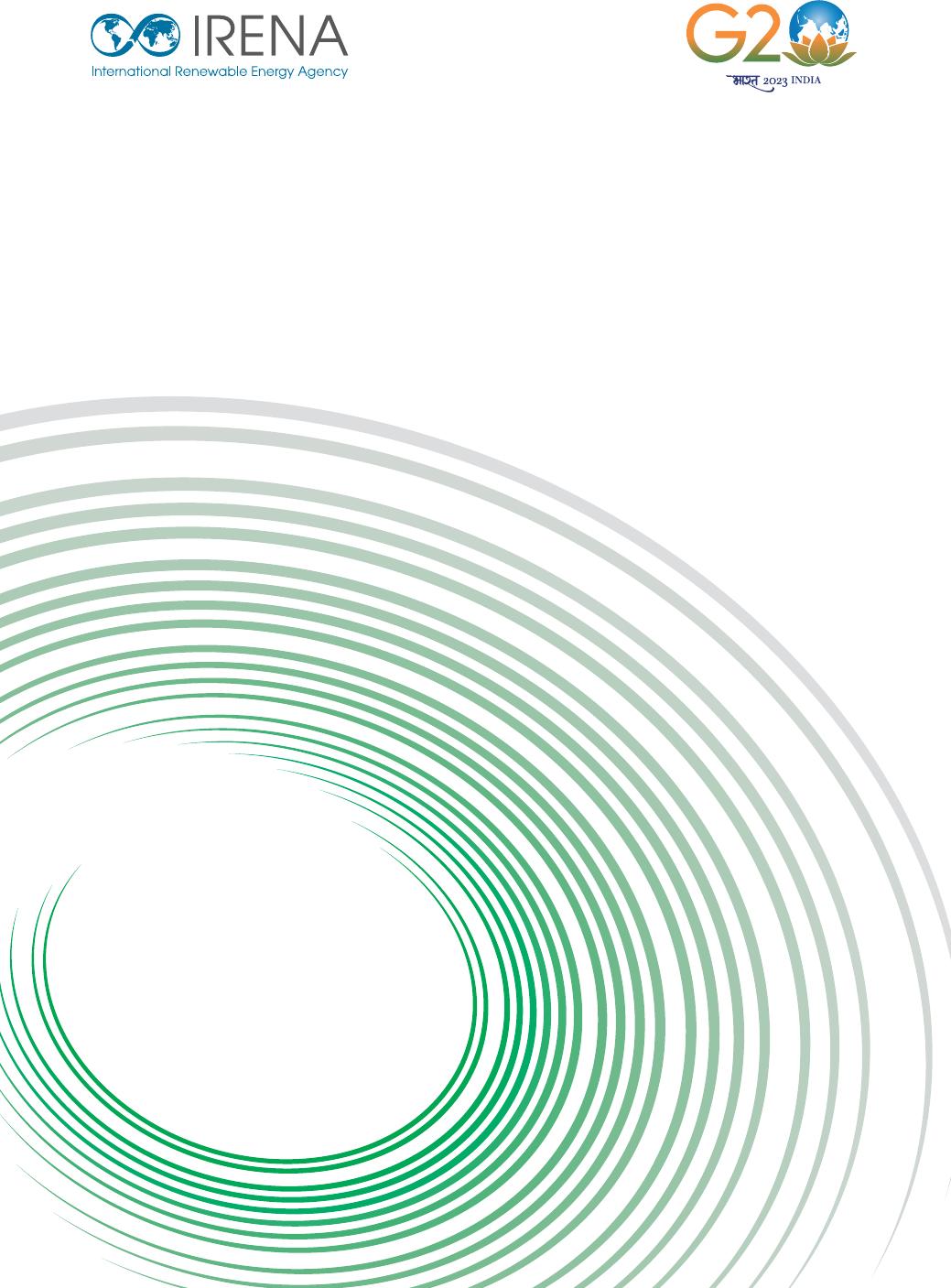TOWARDSACIRCULARSTEELINDUSTRY©IRENA2023Unlessotherwisestated,materialinthispublicationmaybefreelyused,shared,copied,reproduced,printedand/orstored,providedthatappropriateacknowledgementisgivenofIRENAasthesourceandcopyrightholder.Materialinthispublicationthatisattributedtothirdpartiesmaybesubjecttoseparatetermsofuseandrestrictions,andappropriatepermissionsfromthesethirdpartiesmayneedtobesecuredbeforeanyuseofsuchmaterial.ISBN:978-92-9260-538-4Citation:IRENA(2023),Towardsacircularsteelindustry,InternationalRenewableEnergyAgency,AbuDhabi.AcknowledgementsThisreportwaspreparedbyIRENAincollaborationwiththeMinistryofEnvironment,Forest,andClimateChange(MOEF&CC)andTheGroupofTwenty(G20)undertheIndiaPresidencyheldfrom1December2022to30November2023.IRENAisgratefulforthesupport,externalreviewsandfeedbackreceivedfromtheMOEF&CCandG20EnvironmentandClimateSustainabilityWorkingGroup.ThisreportwasdevelopedundertheguidanceofRolandRoesch(Director,InnovationandTechnologyCenterofIRENA)andFranciscoBoshell(IRENA),bythefollowingauthors:KaranKochhar,LuisJaneiro,JungwooLee,ElsyMilanandLiangXinyu.SpecialthanksareduetoGauriSingh(DeputyDirector-GeneralofIRENA)forheroverallleadershipandinvaluableinsightsprovidedthroughoutthereportdevelopmentprocess.IRENAalsowouldliketoexpresssincereappreciationtothefollowingtechnicalexpertswhoreviewedthereportandprovidedinsightfulfeedback,specificcommentsandconstructivesuggestions:SamuelFlückiger,TillKötter(ThyssenkruppSteelEurope),WillHall(InternationalEnergyAgency),ÅsaEkdahl,AndrewPurvis(WorldSteelAssociation),DolfGielen(theWorldBankGroup),RajivMangal(TataSteelIndia),MaxÅhman(LundUniversity),HenkReimikandPaulKomoraswellasIRENAcolleaguesincludingZafarSamadov,BinuPrathan,EmanueleBianco,MariaInesJacobandKaranpreetKaur.DesignwasprovidedbyPhoenixDesignAid.AboutIRENATheInternationalRenewableEnergyAgency(IRENA)isanintergovernmentalorganisationthatsupportscountriesintheirtransitiontoasustainableenergyfuture,andservesastheprincipalplatformforinternationalco-operation,acentreofexcellence,andarepositoryofpolicy,technology,resourceandfinancialknowledgeonrenewableenergy.IRENApromotesthewidespreadadoptionandsustainableuseofallformsofrenewableenergy,includingbioenergy,geothermal,hydropower,ocean,solarandwindenergy,inthepursuitofsustainabledevelopment,energyaccess,energysecurityandlow-carboneconomicgrowthandprosperity.DisclaimerThispublicationandthematerialhereinareprovided“asis”.AllreasonableprecautionshavebeentakenbyIRENAtoverifythereliabilityofthematerialinthispublication.However,neitherIRENAnoranyofitsofficials,agents,dataorotherthird-partycontentprovidersprovidesawarrantyofanykind,eitherexpressedorimplied,andtheyacceptnoresponsibilityorliabilityforanyconsequenceofuseofthepublicationormaterialherein.TheinformationcontainedhereindoesnotnecessarilyrepresenttheviewsofallMembersofIRENA.ThementionofspecificcompaniesorcertainprojectsorproductsdoesnotimplythattheyareendorsedorrecommendedbyIRENAinpreferencetoothersofasimilarnaturethatarenotmentioned.ThedesignationsemployedandthepresentationofmaterialhereindonotimplytheexpressionofanyopiniononthepartofIRENAconcerningthelegalstatusofanyregion,country,territory,cityorareaorofitsauthorities,orconcerningthedelimitationoffrontiersorboundaries.©IRENA2023TOWARDSACIRCULARSTEELINDUSTRY5Theironandsteelsectorisresponsibleforroughly7%ofoverallcarbondioxideemissions,makingitoneofthemostnotablecontributorstoclimatechange.However,theindustryalsoplaysacrucialroleintheglobaleconomy,providingessentialmaterialsforinfrastructure,transportationandmanyothersectors.Theproductionandconsumptionofsteelarelikelytorisewiththegrowthofemergingeconomies.Circularityapproachescanhelppromotetheefficientuseofsteelanditsproductioninputs.Althoughtheseapproachesareessential,theywillnotbesufficienttomitigatetheenvironmentalimpactsarisingfromthesteelsectorinthelongterm.Thisreportproposestheuseofrenewableenergyinsteelproduction-asanintegralcomponentofcircularapproaches-totransformthesteelindustryaswestrivetoachieveasustainableandnet-zerofuture.Adoptingthecircularprinciplespresentedinthisreportcanhelpclosetheloopinthematerialvaluechainofsteelandreducegreenhousegasemissionsfromthesector.Theglobalnatureofsteelnecessitatescoordinatedactiontoovercomecommonchallengesandseizeopportunities.G20membersaccountforaboutfour-fifthsoftheworld’sproductionandconsumptionofsteel,andcollaborationamongmemberscanacceleratetheadoptionofcircularity.Byworkingtogether,G20memberscanleadthewayinimplementingcircularitybyfosteringtheexchangeofbestpractices,removingtradebarriers,andestablishingcommonstandardsforsustainablesteelproduction.Thisreport,preparedbytheInternationalRenewableEnergyAgency(IRENA)incollaborationwiththeMinistryofEnvironment,ForestandClimateChangeofIndia(MOEF&CC)asacontributiontoIndia’sG20Presidency,exploresthevitaltopicofcircularityinthesteelsectoranditsimplicationsforthefutureofsteelproductionandconsumption.ThereportdrawsuponIRENA’sexpertiseandpreviousanalysisonthesector,includingReachingZerowithRenewables,BreakthroughAgenda2022andIRENA’sInnovationWeek,aswellasinputsfromseveralorganisationsandexperts.Therecommendationsinthisreportprovidetheprinciplesforenhancingcircularitybyleveragingdomesticopportunitiesandinternationalcollaboration.IRENAcontinuestobefullycommittedtosupportingtheG20andourMemberStatesindevelopingactionplansthatpromotecircularityapproachesandtheintegrationofrenewablesinthesteelindustry.FrancescoLaCameraDirector-GeneralInternationalRenewableEnergyAgency(IRENA)FOREWORD6TOWARDSACIRCULARSTEELINDUSTRYTABLEOFCONTENTSFOREWORD...............................................................................................................4FIGURES....................................................................................................................7TABLES.......................................................................................................................8BOXES.......................................................................................................................8ABBREVIATIONS........................................................................................................9EXECUTIVESUMMARY.............................................................................................11CHAPTER1INTRODUCTION........................................................................................................141.1Environmentalrelevanceofthesteelsector........................................................................151.2Steelsectortoday..................................................................................................................161.3Steelproductionroutes..........................................................................................................19CHAPTER2IMPROVINGTHECIRCULARITYOFTHESTEELSECTOR.............................................212.1�Circulareconomymodelsintheironandsteelsector.......................................................212.2Optionstoimprovethecircularityofthesector..................................................................25CHAPTER3ACCELERATINGPROGRESSTOWARDSAMORECIRCULARSTEELSECTOR.............463.1Progresstodate......................................................................................................................463.2Enablingframeworktoaccelerateprogress........................................................................473.3�Recommendedareasforinternationalco-operation.........................................................52REFERENCES............................................................................................................54APPENDICES............................................................................................................597FIGURESFigure1�Sourcesofemissionsinironandsteelproduction........................................................16Figure2�Annualglobalcrudesteelproduction.................................................................................17Figure3Breakdownofsteeldemandbysector...............................................................................17Figure4Steelsupplyandapparentsteelusebyregion,2021..................................................18Figure5Traditionalpathwaysforsteelproduction.......................................................................19Figure6�BreakdownofdifferentproductionmethodsandshareofscrapincrudesteelproductionacrossG20countries,2019......................................................20Figure7�Keyfactorsoftheenvironmentalimpactofsteelproducts,andfourpillarsforacircularitystrategy..............................................................................................22Figure8SixRsofacirculareconomyinthesteelsector.............................................................23Figure9Resourceandeconomicefficiencyinsteel.....................................................................25Figure10�Energyandemissionsintensityofdifferentironandsteelproductionroutes,2019.................................................................................................................................31Figure11�ShareofEAF-basedsteelindifferenteconomiesandevolutionofscrapuseinsteelproduction............................................................................................32Figure12Estimatesonscrapavailableforrecycling......................................................................34Figure13Potentialroleofscraprecyclinginfuturesteelproduction.........................................35Figure14Improvingefficiencyinironandsteelproductionprocesses....................................37Figure15Hydrogen-basedironmakingandsteelmaking................................................................408TOWARDSACIRCULARSTEELINDUSTRYTable1�Resourceefficiencyprinciplesindifferentenduses.....................................................26Table2�Economicefficiencyprinciplesindifferentenduses....................................................27Table3�Materialefficiencystrategies,driversandbarriers.........................................................28Table4�Listofhydrogen-basedironmakingandsteelmakingprojects(non‑exhaustive)........................................................................................................................44Table5�Mainareasofactionforacircularsteelindustry............................................................49Table6�Roleofdifferentstakeholdersinacircularsteeleconomy.........................................50TableA1.1�Scrapavailability:Anoverviewofestimatesfromliterature.....................................54Box1�Frameworkforacircularsteelsector.................................................................................23Box2�LifestyleforEnvironmentprinciplesforthecircularityofthesteelindustry.........24Box3�Benefitsofironandsteelsectorcircularityincombatingclimatechange.............24Box4�Cross-sectoralcircularity:Reuseofslagandotherby-productsfromtheironandsteelsector.................................................................................................................30Box5�Capturingcarbonfromironandsteelproductionprocesses.....................................40Box6�Directelectrificationofironorereductionprocesses....................................................43TABLESBOXES9ALLIANCE�AffordableLightweightAutomobilesAllianceBFblastfurnaceBOFbasicoxygenfurnaceCCUS�carboncapture,utilisationandstorageCEcirculareconomyCO2carbondioxideDRIdirectreducedironEAFelectricarcfurnaceECSWG�EnvironmentandClimateSustainabilityWorkingGroupEJexajouleG20GroupofTwentyGWgigawattH2hydrogenH2-DRIhydrogen-baseddirectreducedironIEAInternationalEnergyAgencyIRENA�InternationalRenewableEnergyAgencykgkilogrammeLCAlifecycleassessmentLiFELifestyleforEnvironmentMtmilliontonnesPVphotovoltaicsSIDERWIN�DevelopmentofnewmethodologieSforInDustrialCO2-freEsteelpRoductionbyelectroWINningtCO2tonneofcarbondioxideULCOSUltra-lowCO2SteelmakingWSAWorldSteelAssociationABBREVIATIONS10TOWARDSACIRCULARSTEELINDUSTRYCountryCodesG20members3-LETTERCOUNTRYCODEFULLNAMEARGTheArgentineRepublicAUSAustraliaBRATheFederativeRepublicofBrazilCANCanadaCHNThePeople’sRepublicofChinaEUTheEuropeanUnionFRATheFrenchRepublicDEUTheFederalRepublicofGermanyINDTheRepublicofIndiaIDNTheRepublicofIndonesiaITATheRepublicofItalyJPNJapanKORTheRepublicofKoreaMEXTheUnitedMexicanStatesRUSTheRussianFederationSAUTheKingdomofSaudiArabiaZAFTheRepublicofSouthAfricaTURTheRepublicofTürkiyeGBR�TheUnitedKingdomofGreatBritainandNorthernIrelandUSATheUnitedStatesofAmericaOthercountries3-LETTERCOUNTRYCODEFULLNAMEARETheUnitedArabEmiratesAUTTheRepublicofAustriaESPTheKingdomofSpainKORTheRepublicofKoreaNLDTheKingdomoftheNetherlandsOMNTheSultanateofOmanROURomaniaSWETheKingdomofSwedenExecutiveSummary11EXECUTIVESUMMARYSteelisavitalmaterialfortheprogressofhumansocieties.Itisusedforawiderangeofapplications,includinginfrastructure,buildings,transportvehiclesandhomeappliances,amongmanyothers.Steelcanberecycledwithoutlossofquality,whichalsomakesitacrucialenablerforatransitiontowardsamorecirculareconomy.Ontheotherhand,thesteelsectorisoneofthemostsignificantcontributorstoclimatechange.Itisresponsibleforabout7%ofglobalenergy-relatedcarbondioxideemissions,sincethemajorityofsteelproductionreliesonfossilfuelsasenergysourcesandasreductantstoprocessironore.Atransitiontowardsafullysustainableandclimate-neutralsteelsectorwillrequiredecisiveactiontocontinueadvancingallleversofcircularity.Keystepsincludeimprovingmaterialefficiency,increasingtheshareofrecycledsteel(asmorescrapbecomesavailableovertime)andmakingsteelproductionprocessesmoreefficient.Whilealltheabovemeasurescanmakeanimportantcontribution,theywillnotbeenoughontheirowntomakethesectorenvironmentallysustainableinthelongrun.Addressingtheglobalclimatechangechallengewillrequireashifttowardssustainableenergysourcesforproducingsteel.Centraltoachievingthisobjectivewillbethescale-upofrenewableenergyuseinthesector.Policyactionatthenationallevelisfundamentaltoachievingthecircularityofthesteelsector,butinternationaldialogueandco-operationintheGroupofTwenty(G20)canplayakeyroleinadvancingcircularitystrategiesforthesector’stransformationglobally.Intermsofmaterialefficiency,blueprintsexistforthesmarter,moreoptimaluseofsteelinkeyconsumingsectors,suchasconstructionandautomobileproduction.Nationalregulatoryframeworkscanactasdriversforthemoreefficientuseofsteel.Recommendedcollaborationarea:Co-operationintheG20,toidentifyandscalebestpracticesinthemajorsteel-consumingsectors,throughmutuallearningandexchangeofregulatoryexperience,cancontributetothemoreefficientuseofsteelglobally.Steelscraprecyclingisatthecoreofashifttowardsgreatercircularityinthesteelsector.Buttheavailabilityofscrapisalimitingfactor,sincesteelproductshavelonglifespans.About30%ofsteelproducedtodaycomesfromrecyclingscrap.Theroleofsteelrecyclingwillcontinuetogrowovertimeasmorescrapbecomesavailableinemergingeconomies,resultinginlargersharesofrecycledsteel,inturnprogressivelyreducingtheneedforprimaryproduction.By2050,abouthalfoftheworld’ssteelproductioncouldcomefromrecycledscrap.Nationalgovernmentscanmakeadifference12TOWARDSACIRCULARSTEELINDUSTRYbyadoptingandenforcingregulationsthatensureenvironmentallysoundandthoroughsteelscrapcollectionandsortingprocesses.Adoptingsuchgoodpracticesintherecoveryofend-of-lifesteelproductsisalsocrucialtominimisescrap’scontaminationbyothermaterials,forexample,copper,therebyenablingtheuseofscrapasinputforhigher-qualitysteelspecifications.Recommendedcollaborationarea:Dialogueandco-operationintheG20cancontributetowardsremovingthebarrierstointernationalscraptrade,allowingscraptobetransportedandusedwhereitcreatesthemosteconomicandenvironmentalvalue.Amorecircularandsustainablesteelsectorcanalsobeachievedthroughmakingsteelproductionprocessesmoreefficient,withwidespreadadoptionofthebestavailabletechnologiesacrosstheG20.TonneofsteelSteelproductTonneofsteelEnergyinputstosteelproductionMaterialinputstosteelproductionXEnvironmentalimpactEnergyinputstosteelproductionEnvironmentalimpact=ConsumptionXMaterialinputstosteelproductionXEconomicserviceofsteelproductSteelproductProductionPillar2ScraprecyclingPillar1MaterialeciencyPillar3ProcesseciencyPillar4RenewableproductionXEconomicserviceofsteelproductFigureS.1�KeyfactorsintheenvironmentalimpactofsteelproductsandfourpillarsofacircularitystrategyExecutiveSummary13Recommendedcollaborationarea:G20memberscanfacilitatetheexchangeofbestpracticesamongnationalpolicymakersandregulators.Thesediscussionsmayfocusonpreventingmarketdistortionsthatdisincentiviseinvestmentsinenergyefficiencyprojects.Implementingbestpracticescanmaketheindustrymorecompetitiveandprovidesufficientincentivestoinvestinimprovingefficiencyindomesticsteelindustries.Ashiftfromfossil-fuel-basedsteeltorenewables-basedsteelwillbecrucialinatransitiontoamoresustainableironandsteelsector.Renewablesalreadysupplyasubstantialfractionofthepowerusedforsecondarysteelproductioninelectricarcfurnacestoday.However,primarysteelproduction,whichaccountsforabout70%oftheglobalsteeloutput,stillreliesalmostexclusivelyonfossilfuels.Onekeyalternativetofossilfuelsforsteelproductionistheuseofrenewablehydrogenforironorereduction,whichenablestheproductionofnear-zero-carbonprimarysteel.Butthehighercostsofproductionwithrenewablehydrogencomparedwithconventionalsteelproductionprocessesposeabarriertoitswidespreadadoption.However,deploymentatscalecouldsubstantiallyreducecosts,alsobenefitingfromfurtherreductionsinthecostsofrenewablehydrogenovertime.Regionswithlow-cost,abundantandhigh-qualityrenewableenergyandironoreresourcesareinthebestpositiontomakehydrogen-basedironorereductioncompetitive.Thiscreatesanopportunityforinternationalco-operation.Ironoreexporterswithabundantandinexpensiverenewablescouldcapturemorevaluebyexportingprocessediron.Importingcountriescouldreducetheoverallcostsofdecarbonisingtheirdomesticindustrieswhileretainingsteelproductionwithintheirborders.Atransitiontowardsrenewables-basedsteelwillrequiredecisivepolicysupportintheearlystagesoftechnologyadoption.Policyactionatthenationallevelcanhelpcreatetheconditionsforinvestmentbydefiningroadmapsforthesector’stransformation,andtheadoptionofsupportingmeasures.However,sincesteelisaninternationallytradedcommodity,multilateralco-ordinationwillbevital.Recommendedcollaborationarea:G20memberscanaccelerateatransitiontowardsrenewables-basedsteelbyco-operatinginseveralareas,includingdialoguetowardsinternationallyagreeddefinitions,standardsandcertificationsforlow-carbonsteel;initialdemandcreationthroughmultilateralpublicprocurementcommitments;knowledgeexchangeontechnologyresearchanddevelopment;professionalskillsneededforthetransition;andtechnicalandfinancialassistancetodevelopingcountries,amongothers.14TOWARDSACIRCULARSTEELINDUSTRY1.INTRODUCTIONIndia’spresidencyoftheGroupofTwenty(G20)hasselectedVasudhaivaKutumbakam(“OneEarth,onefamily,onefuture”)asitstheme,reflectingacommitmenttofosteringcollectiveresponsibilityforasustainablefutureforourplanet.Inlinewiththis,theEnvironmentandClimateSustainabilityWorkingGroup,underIndia’sG20presidency,hasidentifiedfivepriorityareas.Amongthem,thethirdpriorityareaspecificallyemphasisesresourceefficiencyandthepromotionofacirculareconomy.Thereportsetsforthprinciplestoachievetheobjectivessetwithinthistheme,encouragingaholisticapproachtopromotingthecircularityoftheironandsteelsector.TowardsacircularsteelindustrySteelisavitalcommodityforhumanactivities.Almost2billiontonnesofsteelareconsumedannuallyinbuildings,transport,consumergoodsandmachines.Steel’sremarkablestrength,durabilityandrecyclabilitymakeiteasytoworkwithandensureitswidespreaduse.Itisalsoremarkablyversatilesinceitcanbemodifiedbyalloyingitwithdifferentelements,suchasmanganeseandnickel,toensurethedesiredpropertiesforabroadsetofapplications.Steelcanalsoberecycledwithoutlossofproperty,whichmakesitacrucialenablerforatransitiontowardsamorecirculareconomy.Theironandsteelsectorisamongthemostprominentindustriesglobally,withamarketvalueofUSD1.51trillionin2021(GVR,2022).Itservesasthelifelineforseveralcommunitiesandregions,providingdirectemploymenttoover6millionpeoplegloballyandindirectlygeneratingjobsinrelatedsectorsoftheeconomy(IEA,2020).Theironandsteelindustryiscrucialtoafunctioninghumansocietysincecriticalinfrastructuredependsontheavailabilityofsteel.However,themethodsusedtodaytoproducesteelhaveenvironmentalimpacts.Itisthereforeessentialthattheironandsteelsectoristransformedinamannerthatallowsittocontinuetodelivervaluableservicestosocietywhilehavingminimalenvironmentalimpacts.Thisreportexamineshowtheironandsteelsectorcanbecomemorecircular.Itsystematicallylooksateachkeydriverofcircularityforthesector,showcasesbestpracticeexamplesanddiscussesbothtechnologicalandnon-technologicaloptionsatallstagesofthesteelproductionandconsumptionchainforG20countriestoincreasecircularityandminimiseenvironmentalimpact.Introduction151.1ENVIRONMENTALRELEVANCEOFTHESTEELSECTORTheironandsteelsectorwasresponsiblefor2.6gigatonnes(Gt)ofdirectcarbondioxide(CO2)emissionsin2019,representingabout7%ofthetotalenergysectoremissions(includingprocessemissions)(IEA,2020).Steelproductionisenergyintensivesincethemajorityoftheproductionoccursathightemperatures.Thesectorconsumedover35exajoules(EJ)ofenergyin2021(IEA,2020).Additionally,mostironoreisconvertedintometallicironusingfossilfuels,suchascoalandnaturalgas,asreducingagents,releasingCO2intheprocess(reductionisanecessarystep,involvingoxygenremovalfromironoretocreateiron).Upstreamactivitiesconsumingcoalandnaturalgasalsoproducesubstantialmethaneemissions(Kholodetal.,2020).BesidesdirectCO2emissions,currentmethodsofironandsteelproduction–intheabsenceofappropriatepollutioncontrolsystems–canalsohavedetrimentalimpactsonhumanhealth.Dustandvolatilemattercanescapefromrawmaterialpreparation(Figure1),causingairpollution(IEA,2020).Airpollutioncanalsobeanissuewheresuchproductionfacilitiesarelocatednearurbancentres.©Evannovostro/Shutterstock.com16TOWARDSACIRCULARSTEELINDUSTRY1.2STEELSECTORTODAYAlmosteverythingthatsurroundsuscontainssteel–fromlargeobjectssuchasthehousesandbuildingsweliveandworkin,tothetransportvehiclesandinfrastructurethatweutilise,totheappliancesandconsumerproductsthatweusedaily.Agrowingeconomyincreasesthedemandfortheseproductsand,consequently,thedemandforsteel.Inessence,thedemandforsteelcloselyfollowsthedevelopmentofaneconomy,particularlyattheearlystagesofindustrialisation.Also,steel’suseinelectricvehicles,windturbinesandsolarphotovoltaic(PV)structuresmakesitakeyinputmaterialintheenergytransition.Steelproductionhasrisensteadilyovertime.Fromjust190milliontonnesin1950,itgrewtoalmost2billiontonnesin2021(Figure2),duetodemographicgrowthandeconomicdevelopment(WSA,2022).Theincreaseinglobalsteelproductionoverthepastfewdecadeswasdrivenbygrowthinemergingeconomies,particularlyChina.Whilecrudesteelproductioncapacitydoubledintheprevioustwodecades,almostthree-quartersofthecapacitygrowthoccurredinChina(IEA,2020).Thedemandforsteeliscloselytiedwitheconomicactivityinvarioussectors.AsshowninFigure3,52%ofsteelin2019wasusedinbuildingsandinfrastructureand17%intransport.Machineryconsumedone-fifthofthesteel,whileconsumergoodsrepresentedapproximatelyone-tenthofthetotalsteeldemand.Thesteelusedinconstructionisstoredinproductsandstructuresforextendedperiods,andthusconstitutesthebulkofthesteelinuse(Pauliuk,WangandMüller,2013).In2021,bothsteeldemandandproductionexperiencedvolatilitytriggeredbysupplychainissuesandlockdownsinresponsetotheCOVID-19pandemic.However,steeldemandreboundedquicklyasthesteel-consumingconstructionandautomotivesectorsrecoveredfasterthanothersectors(WSA,2020).Figure1�SourcesofemissionsinironandsteelproductionBasedon:(CarbonSmartMaterialsPalette(n.d.)).EmissionsEmissionsEmissionsMiningandupstreamenergycarriersIronandsteelproductionTransportIntroduction17Figure2�Annualglobalcrudesteelproduction-Globalcrudesteelproduction(Mt)Source:(WSA,2022).Note:Mt=milliontonnes.Theironandsteelindustryisglobalinnature.Ninety-onecountriesproducecrudesteelinsubstantialquantities,consumedacrosstheworld.Meanwhile,afewjurisdictionsdominateglobalsteelproduction.Chinaproducesmorethanhalfoftheglobalcrudesteeloutput,followedbytheEuropeanUnion,IndiaandtheUnitedStates.Theseregionsproduceroughly70%ofthesteelglobally.Similarly,alargeshareofsteelconsumptionisconcentratedintheseregions,whichconsume70%ofthetotalsteelproducedglobally(Figure4)(IEA,2020).Figure3BreakdownofsteeldemandbysectorBuildingsandinfrastructureAutomotiveMetalproductsMechanicalequipmentOthersSource:(WSA,2018a).18TOWARDSACIRCULARSTEELINDUSTRYFigure4Steelsupplyandapparentsteeluseabyregion,2021ChinaIndiaEUUnitedStatesOtherAsiaRoWCrudesteelproductionApparentsteeluseSource:(WSA,2022).Note:EU=EuropeanUnion;RoW=restoftheworld;a“Apparentsteeluse”isdefinedasthesumofthesteelproduceddomesticallyandnetdirectimports.©Humphery/Shutterstock.comIntroduction191.3STEELPRODUCTIONROUTESSteelcanbeproducedfromironoreandrecycledsteelscrap.Primarysteelproductionreferstotheoperationsinwhichironoreisusedasthemainmetallicinput,whereassecondaryproductionprocessesarebasedonscrap.Scrapisalsousedinprimaryproductionalongwithironoreascoolingmaterialandmetallicinput.Inprimaryproduction,theironoreisreducedtoiron.Today,thisisprimarilydoneintwoways–inablastfurnace(BF)orinadirectreducediron(DRI)shaftorkilnfurnace.TheironoutputfromtheBFisprocessedinabasicoxygenfurnace(BOF),whereastheoutputfromtheDRIfurnaceistypicallyprocessedinanelectricarcfurnace(EAF),forthenextstage,whichisalsocalledsteelmaking(Figure5)(IRENA,2020).Today,theBF-BOFistherouteforroughly70%ofglobalsteelproduction,andconstitutes90%ofprimaryproduction(IEA,2020).Ontheotherhand,secondaryproductionusesrecycledsteelscrap.Secondaryproductionuseselectricityasthemainenergyinputinsteadofcoalandnaturalgas,whichareusedinprimaryproduction.Spongeiron,theoutputfromtheDRIfurnace,canbefedtotheBOF.Approximately30%ofglobalsteelproductionusesscrapasmetallicinputtotheprocess(IEA,2020).Today,G20countriesproduceapproximately85%ofthetotalcrudesteeloutputglobally.Themainproductionroutesvaryamongcountriesdependingonaccesstorawmaterial,energy,technologicaldevelopmentandeconomicdevelopment.Availabilityofscrap–drivenbyhistoricsteelconsumption–isoneoftheprimaryfactorsdeterminingthedevelopmentoftheproductionprocessused(Figure6).Scrapavailabilityvariessignificantlybetweenmatureanddevelopingcountries,withthelattertypicallymorereliantonprimaryproductionmethodstomeetsteeldemand.Figure5TraditionalpathwaysforsteelproductionIronreductionBlastFurnaceIronoreGasCoalOilElectricityShaftFurnaceGasCoalSteelproductionBOFScrapsteelEAFElectricityEAFBF-BOFrouteDRI-EAFrouteSecondaryproductionrouteCrudesteelCrudesteelCrudesteelFinishedsteelproductsDownstreamprocessingElectricityIronoreOxygenScrapsteelElectricityScrapsteelBasedon:(Lopez,FarfanandBreyer,2022).Note:BF=blastfurnace;BOF=basicoxygenfurnace;DRI=directreducediron;EAF=electricarcfurnace.20TOWARDSACIRCULARSTEELINDUSTRYFigure6�BreakdownofdifferentproductionmethodsandshareofscrapincrudesteelproductionacrossG20countries,2019ITATURUSAIDNEU27MEXZAFSAUARGFRAKORDEUAUSCANBRAJPNINDGBRRUSCHNBOFEAFOtherITATURUSAIDNEU27MEXZAFSAUARGFRAKORDEUAUSCANBRAROWJPNINDGBRRUSCHNShareofscrapincrudesteelproductionGAverageSource:(Bataille,StiebertandLi,2021;WSA,2020).Note:BOF=basicoxygenfurnace;EAF=electricarcfurnace;G20=GroupofTwenty;ARG=TheArgentineRepublic,AUS=Australia,BRA=TheFederativeRepublicofBrazil,CAN=Canada,CHN=ThePeople’sRepublicofChina,EU=TheEuropeanUnion,FRA=TheFrenchRepublic,DEU=TheFederalRepublicofGermany,IND=TheRepublicofIndia,IDN=TheRepublicofIndonesia,ITA=TheRepublicofItaly,JPN=Japan,KOR=TheRepublicofKorea,MEX=TheUnitedMexicanStates,RUS=TheRussianFederation,SAU=TheKingdomofSaudiArabia,ZAF=TheRepublicofSouthAfrica,TUR=TheRepublicofTürkiye,GBR=TheUnitedKingdomofGreatBritainandNorthernIreland,USA=TheUnitedStatesofAmericaImprovingthecircularityofthesteelsector212.�IMPROVINGTHECIRCULARITYOFTHESTEELSECTOR2.1�CIRCULARECONOMYMODELSINTHEIRONANDSTEELSECTORThecirculareconomy(CE)isaconceptthatreferstotheconversionoflinearproductvaluechainsintocircularlifecycles.CommonlyuseddefinitionsofCEtendtofocusonreducing,reusingandrecyclingproductsorrawmaterialstoavoidwastage.Fortheironandsteelsector,materialefficiencyandscraprecyclingareessentialpillarsofcircularity.Whiletheseareimportantaspects,abroaderdefinitionshouldalsoincorporatethesustainabilityoftheenergysourcesandreductantsusedintheproductionprocess,sincethesearekeydriversofthesector’senvironmentalimpact.Theglobalsteelsectorisalreadycirculartoanextent.About30%ofthesteelproducedtodaycomesfromscraprecycling.Itisalsopossibletorelyonrenewablepowersourcestoproducerecycledsteel.However,moststeelproducedtodaystillreliesonfossilfuelsasenergysourcesandreducingagentsforironoreprocessing.Figure7showsabreakdownofthekeyfactorsdrivingtheenvironmentalimpactofsteelproducts,andfourrelatedpillarsforincreasedcircularity.Thesteelsectorwillbecomemorecircularbydeployingmaterialefficiencymeasures,increasingtheshareofrecycledsteelasmorescrapbecomesavailableovertime,deploying(process)efficienttechnologiesandtransitioningtoproductionmethodsthatuserenewableenergysourcesandalternative“green”reducingagents.Atransitiontowardsafullycircularsteelsectorinthefutureshouldconsideralltheseleverstodeliverameaningfulimpact.22TOWARDSACIRCULARSTEELINDUSTRYGivenbelowarebriefexplanationsofhowthefourpillarscontributetothecircularityofthesteelsector:•�Materialefficiencyinsteeluse:Materialefficiencymeasurescancontributetoadvancingthecircularityoftheironandsteelsectorbyoptimisingtheuseofsteelproducts.Thesemeasuresincludeproducinglightersteelproductsandstructures,refurbishingandreusingsteelproducts,andredesigningproductswithalternativematerialswhenjustifiedbasedonlifecycleanalysis.•�Steelscraprecycling:Recyclingsteelimprovescircularitybyallowingsteelfromend-of-lifeproductstoberepurposedforotherapplications.Steelrecyclingreducestheneedforprimarysteelproduction.•�Processefficiency:Improvingenergyefficiencyenhancescircularitybyminimisingtheneedforresourcesinsteelproduction.Processefficiencyreducestheenvironmentalimpactoftheproductionprocessesproportionally.•�Renewables-basedsteelproduction:Atransitiontowardsrenewables-basedsteelproductionentailsastructuralshiftawayfromfossilfuelsassourcesofenergyandreducingagents.Oneofthemostpromisingoptionsistheuseofrenewableenergyandgreenhydrogentoreduceironore.Ashifttousingrenewablescanimprovetheenvironmentalperformancefrommoreenvironmentallyfriendlyironandsteelandreducethedependenceonfinitefossilfuels,inturnadvancingcircularity.Figure7�Keyfactorsoftheenvironmentalimpactofsteelproducts,andfourpillarsforacircularitystrategyTonneofsteelSteelproductTonneofsteelEnergyinputstosteelproductionMaterialinputstosteelproductionXEnvironmentalimpactEnergyinputstosteelproductionEnvironmentalimpact=ConsumptionXMaterialinputstosteelproductionXEconomicserviceofsteelproductSteelproductProductionPillar2ScraprecyclingPillar1MaterialeciencyPillar3ProcesseciencyPillar4RenewableproductionXEconomicserviceofsteelproductImprovingthecircularityofthesteelsector23Box1�FrameworkforacircularsteelsectorCirculareconomyprinciplesaimtocapturemaximumvaluefromaproductthroughcontinuousloopsinitsvaluechain.Theprinciplesaimtoensureaconstantflowofmaterialbetweenmanufacturingandthefinal-usestage,minimisingtheneedforprimarymaterialateachstep.Essentially,circulareconomyprinciplesaimtotransformhowtheproductionsystemworkstobenefitbusiness,societyandtheenvironment.Theprinciplesincludereusing,redesigning,reducing,remanufacturing,recoveringandrecycling(Jayaletal.,2010).Inapplyingtheseprinciples,itisimportanttotakeintoaccounttheoveralllifecycleimpactofsteelproductsversusalternativematerials.Figure8SixRsofacirculareconomyinthesteelsectorReduce:Usingalternativematerialscanenableaproducttoprovidethesameserviceswithlessmaterialsorgreaterefficiency.Redesign:Productsmaybedesignedtouselesssteel.Measuressuchaslightweightingusinghigh-strengthsteelcandrasticallyreducethesteelrequiredinaproduct.Remanufacture:Repairandrefurbishmentsallowaproducttobesoldfororiginaluseinprimaryandsecondarymarkets.Reuse:Aproductinitsoriginalformcanbeusedtoperformthesamefunctionmorethanonce.Businessmodelsmaygrantsuchproductsaccesstosecondarymarkets.Recover:Recoveryinvolvescollectingandsortingmaterialthatcannotbereusedorremanufacturedsinceitsserviceablelifehasendedorthefunctionitservedisnolongerneeded.Recycle:Throughtheprocessofrecycling,metalmaybetransformedfromanend-of-lifeproductintoanewlyusablecommodity.Recyclingsteelsavessignificantenergyandcarbonemissionsrelativetoproducingnewsteel.Steelcanberecycledmultipletimeswithoutlossofqualityorfunctionality;itcanevenberecycledtoimproveitsqualitytosuitanewserviceorenduse.Thecircularityoftheironandsteelindustrywillentailasuiteoftechnologicalsolutions,policyinterventions,innovativefinancialandbusinessmodelstoeliminatewasteandemissions,andcirculatingproductsandsourcematerials.UserServiceProviderRenewableenergyandfiniteresourcesEnergyeciencymeasuresRecoverReuseReduceRemanufactureRecycleProductmanufacturerSteelmanufacturer24TOWARDSACIRCULARSTEELINDUSTRYBox2�LifestyleforEnvironmentprinciplesforthecircularityofthesteelindustryTheLifestyleforEnvironment(LiFE)movementwaslaunchedbytheIndianprimeministeratthe2021UnitedNationsClimateChangeConferenceinGlasgowinNovember2021.Itfocusesonthemindfulanddeliberateutilisationofresources,whichareatthecoreofthesteelsector’scircularity.ThekeypillarsoftheLiFEmovement–focusonindividualbehaviours,co-creategloballyandleveragelocalcultures–alignwellwiththefourpillarsofthesteelindustry’scircularity:•Focusonindividualbehaviours:Promotingcirculareconomyprinciplescanhelpmotivateindividualstomakemoresustainablechoiceswhenpurchasingsteelproducts.Forexample,theymaypreferbuyingproductsmadefromrecycledsteelorproductsthataredesignedtobeeasilyrepairedorrecycled.•Co-createglobally:Collaborativeeffortsbetweengovernmentsandthesteelindustrygloballycanfacilitatethesharingofknowledgeandbestpracticestoboostmaterialefficiency,increasesteelrecyclingandpromotelow-carbonsteelproduction.Thiscanincludepartnershipsbetweensteelmanufacturers,governmentsandenvironmentalorganisationstodevelopnewtechnologiesandstandardsthatpromotecircularity.•Leveragelocalcultures:Localculturescanbeleveragedtopromotecircularitybybuildingawarenessandengagingcommunitiesincirculareconomyinitiatives.Traditionalpractices,suchasrepairandreuseofitems,canbeappliedtosteelproducts,andlocalartisanscandevelopnewdesignsforsteelproductsthatcanberecycledorrepairedmoreeasily.Box3�BenefitsofironandsteelsectorcircularityincombatingclimatechangeTheironandsteelsectorisresponsibleforabout7%ofglobalenergy-relatedcarbondioxideemissions,makingitoneofthemostsignificantcontributorstoclimatechange(IRENA,2020).Thesector’sclimateimpactswillcontinuetogrowalongsideemergingeconomiesunlessactionistaken.Thesectorisoneofthehardesttodecarbonise.Today,itreliespredominantlyonfossilfuelsasenergysourcesandforrawmaterialprocessing.Atransitiontowardsaclimate-neutralsteelsectorwillrequireafundamentalshiftinenergysources,reducingagentsandsteelproductionprocesses.Thisincludesatransitiontowardsarenewables-poweredsupplyforsecondarysteel,butalso,moreimportantly,towardsrenewables-basedtechnologiesforprimarysteel,whichaccountsforabout70%oftoday’ssteelproduction.Besidesthesefundamentalshifts,othercircularityapproachescansubstantiallycontributetoaddressingtheglobalclimatechangechallenge.Theseincludemoreefficientuseofsteelthroughmaterialefficiency,minimisingtheneedforprimarysteelproductionbyrecyclingincreasingquantitiesofscrapastheybecomeavailableandmakingsteelproductionprocessesasefficientaspossible.Aholisticapproachtowardsthesector’stransformation,consideringallleversofcircularity,canaccelerateprogresstowardscarbonneutralityinthesteelindustry.Furtherresearchcanhelpquantifythecumulativedecarbonisationpotentialoftheseleversintheironandsteelsector.ThisisapossibleareatobeadvancedbyfutureG20presidencies.Improvingthecircularityofthesteelsector252.2OPTIONSTOIMPROVETHECIRCULARITYOFTHESECTORCircularitystrategy1:ReducesteeldemandthroughincreasedmaterialefficiencyImplementingmaterialefficiencymeasurescanhelpadvancecircularityintheironandsteelsectorbyoptimisingtheuseofsteelproducts.Thesemeasureshelpmitigatesteeldemand,reducingthepaceoftherequiredtechnologicalshifttosustainablesteelproductionprocesses.Apartfromreductionindirectmaterialdemand,materialefficiencystrategiescanalsobringvarioussystemicenvironmentalandeconomicbenefitsbeyondthesteelsector.Forexample,theuseofhigh-strengthsteelinvehiclesmakesthemlighter,andreducestheirfuelconsumptionandemissions,whilehelpingthemmaintainserviceefficiency.Thisisparticularlytrueofelectricvehicles,whichhavesmallercarbonfootprints.Weconsidertwotypesofefficiencymeasures,bothofwhichusetechnicalinterventions,consumerpreferences,businessmodelsandpolicyinstrumentstoreduceend-usesteelconsumption(Figure9)(Allwoodetal.,2013):1.�“Resourceefficiency”measuresinvolveprovidingthesameservicewithlesssteel.Thesemeasuresareimplementedatthe“design”,“manufacture”and“use”stagesofsteelvaluechainsandattheirendoflife.2.�“Economicefficiency”measurescaneitherextendtheserviceablelifeofasteelproductorhelpitdelivermoreserviceswiththesamequantityofmaterialinputs.Theseinterventionsareimplementedatthe“design”and“use”stagesofsteelvaluechains.MaterialeciencySameproductwithlesssteelReusingsteelIntensiveuseandsharingLifetimeextensionResourceeciencyEconomiceciencyFigure9Resourceandeconomicefficiencyinsteel26TOWARDSACIRCULARSTEELINDUSTRY“Resourceefficiency”measures(Table1)canbeimplementedusingtwostrategies:1.�“Sameproductwithlesssteel”involvesreducingthequantityofsteelneededtoproduceaunitofenduse.Anexampleofthisistheuseof“lightweighting”techniquesthatoptimisedesignstogetherwithhigh-strengthsteelorsteelsubstitutestominimisevehicles’weight.2.�“Reusingsteel”allowsrepurposingsteelfromend-of-lifesteelproductsforotherapplicationswithminimumprocessing.Thisstrategyusesnegligibleenergycomparedwithbothprimaryandsecondarysteelproductionandcanplayaroleinastrategytoimproveresourceefficiency.1Whenconsideringthesubstitutionofsteelwithalternatives,thefulllifecycleimpactofbothmaterialsshouldbeevaluated.2�Extendingavehicle’slifetimemayreduceemissionsduetomaterialuse,butitcanleadtohigheremissionsperkilometreduetoperformancedifferencesinfuelefficiencybetweenoldandnewinternalcombustionengines,andbetweenhybridandelectricvehicles.Table1�ResourceefficiencyprinciplesindifferentendusesENDUSESAMESERVICEWITHLESSSTEELREUSEConstructionHigher-strengthrebaranddesignoptimisationtoreducedemandModularstructurestoenablerelocationTransportReducingsteeluseinvehiclesthroughlightweightdesignandmaterials(high-strengthsteel,aluminiumandcarbonfibre,amongothers)1SecondarymarketstoallowforreuseofproductswithsteelcontentMachineryandconsumergoodsComputer-aidedmanufacturingcanproduceunitswithlesswastageBasedon:(Wangetal.,2021).“Economicefficiency”measures(Table2)canbeimplementedusingthefollowingstrategies:1.�Lifetimeextension:Betterdesignforrepairabilitycanhelpextendaproduct’slifetime.Repairinglightlydamagedpartsofproducts,especiallyconsumerproductsandvehicles2,cansignificantlyextendtheirusefullife.2.�Moreintensiveuse:Thisinvolveschangesinbehavioursandpreferencestoincreasetheusefulserviceofindividualsteelproducts.Forvehicles,severaloptionscanbeconsidered,suchascarsharing(shiftfrompersonaltosharedcars)andride-sharing(amongpeoplewiththesameorsimilardestinations).Aswitchtopublictransportmodesfromprivatetransportalsoincreasestheutilisationrateofsteelproducts.Forbuildings,ashifttoco-workingspacesorworkingfromhome,amongothers,improvestheutilisationofthebuiltsurface,whichisakeydriverofsteeldemand.Improvingthecircularityofthesteelsector27Table2�EconomicefficiencyprinciplesindifferentendusesENDUSEINTENSIVEUSEANDSHARINGLIFETIMEEXTENSIONConstructionHigherutilisationratesofbuiltspaceRenovationandrefurbishmentofexistingbuildingsTransportRide-sharingandswitchingtopublictransportBetterdesignforrepairability,refurbishmentandreuseMachineryandconsumergoodsEquipmentsharingBasedon:(Wangetal.,2021).UnderstandingthepotentialMaterialefficiencystrategiescanhaveasubstantialimpactonthedemandforsteel.TheInternationalEnergyAgency’sIronandSteelTechnologyRoadmapestimatesthatacombinationofmaterialefficiencymeasurescoulddecreasetheglobalprojectedsteeldemandbyaboutafifthby2050(IEA,2020).Themostsignificantdriversofthisdemandreductionareimproveddesignandconstruction,andextendedlifetimesofbuildings.“Lightweighting”andintensiveuseofvehiclesaretheprimarydriversofthedemandreductionforthetransportsector.Apartfromspecificsectors,significantdemandreductionscanbeaddedbypromotingthereuseofproductsacrossapplicationswithoutremelting.ChallengestoimplementingmaterialefficiencystrategiesMaterialefficiencymeasuresholdsignificantpotentialtodeliverenvironmentalandnon-environmentalbenefits,buttheycanbechallengingtoexecute.Table3outlinesseveralmaterialefficiencystrategiesalongwithdriversandbarriers.Theadoptionofmaterialefficiencymeasuresoftenrequirestechnicalchangesthatcannotbeimplementedimmediately.Forexample,itcantaketheautomotivesectorseveralyearstoredesignvehicleframesoradopthigher-strengthalloys,whileensuringsafetyandperformancestandards,adaptingproductionprocessesandrealigningupstreamsupplychains.Regulatoryframeworkscanalsobeabarriertotheadoptionofcertainpractices.Forinstance,designstandardsintheconstructionsectormaylimittheuseofalternativematerials.Thesestandardscouldincludebuildingcodesthatprescribematerialsratherthanperformancespecifications(UNEPandIRP,2020).Implementingmaterialefficiencymeasuresmightrequireinvestmentsinnewtechnologiesandprocesses,whichcouldbeespeciallychallengingforcompanieswithlimitedfinancialresources.Thesecouldinclude,forinstance,additivemanufacturingtechnologies,whichreducethematerialinputneededtomanufactureaproduct.Apartfromchallengeswithaccesstofinancialresources,suchcompaniescouldalsofacechallengesinupskillingorfindingskilledlabourtodesignand28TOWARDSACIRCULARSTEELINDUSTRYuseadvancedtechnologies.Thiscanbepotentiallylimitinginsectorssuchascomponentmanufacturingforautomobiles,whichmayrequiresignificanttechnicalexpertise.Therecanalsobealackofawarenessoftheneedtomeasurerelevantdata(e.g.onmateriallossesandyieldrates)tojustifytheimplementationofmaterialefficiencymeasures.Lackofdata,andinseveralsituations,lackofdatasharingamongregulators,alsoleadstoformulationofineffectivepolicies.Culturalfactorsandpractices,beliefsandbehaviouralroutinescanalsosometimesactasbarrierstomaterialefficiencyandtheenergytransitioningeneral(SovacoolandGriffiths,2020).Forinstance,localcustomsinsomeregionsmayinfluenceindividualstoprioritisebuyingnewlybuilthomesoverrentingorrefurbishingexistinghomes(UNEPandIRP,2020).Incertainregions,owningacarisconsideredprestigiousdespitetheavailabilityofcarsharingservices.Table3�Materialefficiencystrategies,driversandbarriersSECTORSTRATEGYDRIVERSBARRIERSBuildingMoreintensiveuseHighurbanisationratesPrescriptivedesignconventionsUsinglessmaterialbydesignHighconstructioncostsandmetalpricesLifetimeextensionComplexityofrenovationprojectsReuseMissingsupplychainactors,dismantlingcostsTransportMoreintensiveuseGreaterflexibilityinmobilityUsinglessmaterialbydesignIncreasingfuelstandardrequirementsHighsubstitutematerialcostsLifetimeextensionStandardisationandautomationofrepairprocessNewmodelsforcarsReuseHighmetalpricesPoorscrapsteelquality,complexsupplychainsBasedon:(UNEPandIRP,2020).Casestudiesformaterialefficiency•Lightweightingincars–ALLIANCE(AffordableLightweightAutomobilesAlliance)�SixEuropeancarmakers,alongwithseveralsuppliersandpartners,formedacoalitionknownasALLIANCEin2016toaddressthechallengesoflightweightdesignbyusingadvancedhigh-strengthsteelandmaterialselection(ALLIANCE,n.d.).Improvingthecircularityofthesteelsector29�Theproject’sresultsshowthatasignificantweightreductionofupto33%ispossiblewithanadditionalcostofEUR3orlessperkilogrammesaved.Thefocusondevelopingtechnologiestooptimisefuelandenergyconsumptionholisticallyhasresultedinthecreationofvehicleprototypesthataretargetedformarketapplicationby2025.ALLIANCEhasfurtherdevelopedseveralsupporttoolstoensurethemarketviabilityofthedevelopedtechnologies.•Lightweightinginconstruction–STIGASportsArenaEskilstuna,Sweden�STIGASportsArena,whichopenedin2017,islocatednearStockholm.Thecomplexhostssportingevents,concertsandconventions,withitsmainarenacomprising3700seatsforsportingeventsandapproximately5000seatsforconcerts.DesignersandotherprojectpartnerschoselightweighttrussessincetheyaremoreeconomicalthanalternativessuchasI-beams.Usinghigh-strengthsteelwithtrussesledtolighterandsturdierstructures,resultinginloweroverallsteeluse(SCI,2019).•Extendingthelifeofmachinesandhouseholdproducts–CoreCentricsSolutions�CoreCentricsSolutionsisaUS-basedenterprisethatrunsarepairanddistributionnetworkfordefectivehouseholdproductsandmachineparts.Thecompanyteamswithsomeoftheworld’slargestretailersandconsumergoodsmanufacturers,operatingalargerepairprogrammeandredistributionnetworks(EllenMacArthurFoundation,n.d.[a]).Whiletherepairprogrammereducestheneedforfrequentproductreplacements,theredistributionnetworkscreatereliablesecondarymarketsforrefurbishedcomponentsandproducts.CoreCentric’sbusinessallowsproductstohavealongerpracticallifeandhigherutility.©AnusornAbthaisong/Shutterstock.com30TOWARDSACIRCULARSTEELINDUSTRY•Equipmentsharingapplication–Rheaply�Rheaplyenablesthesharingofunusedassetsbetweenandwithinorganisationsandinstitutions,therebyreducingnewdemandforresource-richproductsthatareusedinfrequently(EllenMacArthurFoundation,n.d.[b]).Itletsuserskeeptrackofinventory,allowingmachinesandequipmenttobesold,leasedorrented.•Reusingbuildingstructure–TheVanUnnikbuildingatUtrechtUniversity�TheVanUnnikbuildingatUtrechtUniversity,theNetherlands,ismorethan50yearsold.Insteadofconstructinganewbuildingcompliantwithcurrentstandards,theexistingbuildingwillberedevelopedkeepingtheresource-intensiveskeletonintact(UtrechtUniversity,2023).Thisprocesswillreducethematerialloadneededtodevelopabuildingcompliantwithbuildingcodes.Circularitystrategy2:MaximisethepotentialofrecycledsteelSteelcanberecycledinfinitelywithoutlossofqualityandremadetohaveanygrade.Recyclingsteelscrapfromend-of-lifeproductsisanestablishedpracticeasitmakeseconomicsenseforsteelproducerstoadopttheless-energy-intensiverecyclingprocessthanproducingnewsteelfromironore(Wangetal.,2021).Today,about30%oftheworld’ssteelisproducedfromrecycledsteelscrap(BIR,2010,2011,2012,2013,2014,2015,2016,2017;WSA,2020).Box4�Cross-sectoralcircularity:Reuseofslagandotherby-productsfromtheironandsteelsectorUsinglimefluxessuchaslimestoneanddolomitetoremoveimpuritiesinindustrialprocessesresultsinslagasaco-product.Onetonneofsteelproducesroughly400kilogrammes(kg)ofslagfromironore,ofwhich275kgcomefromtheblastfurnace(BF)andtherestcomesfromabasicoxygenfurnace(BOF)(WSA,2018b).About110kgofslagarealsogeneratedwhilerecyclingsteelinanelectricarcfurnace.Ratherthanametallurgicalwaste,theconfigurationsandpropertiesofslagaredesignedtooptimiseironandsteelmakingoperations.Duetoitsproperties,slagcanbeusedasasubstitutefordifferentmaterialsinseveralindustrialapplications.ThemostprominentuseofBFslagisintheconstructionsector,whereitisusedasasubstituteforclinker,themostemission-intensiveingredientincementproduction.Slagcanconstitutelargesharesoftheclinker’sweightalongwithothersubstitutes,proportionallyreducingemissionsfromcementproduction(IEA,2020).Itcanalsoserveasacoarseandfineaggregateforconcrete.BFslagcanalsobeusedinproducingfertilisers.Slagfromsteelmakingcanalsobeusedintheconstructionofroadsandasanaggregateforasphaltconcrete(NipponSlagAssociation,n.d.).Ironandsteelmakingoperationsproducesignificantvolumesofgasesfromthecokeoven,BFandBOF.Significantamountsofenergycanberecoveredfromthesefluegaseswhenconvertedintopower(Cavaliere,2019).Also,carbondioxidefromblastfurnacegascanbecapturedforconvertingfeedstocksfordifferentindustries.Improvingthecircularityofthesteelsector31SteelrecyclingiscentraltoaCEstrategyasitnotonlyreducestheneedforextractingironorebutalsocontributestoemissionsreductions(Figure10).Moreover,withrenewables’shareinelectricitygridsincreasing,recycledsteelwillhaveareducedenvironmentalimpactovertimewithoutadditionalactionswithinthesector.3Incountrieswithalongerandmoreintensehistoryofindustrialisation,aconsiderablefractionofnewsteelcanusuallybeproducedfromsteelscrap(Figure11).Thisisduetothesubstantialstockofsteelaccumulatedintheireconomiesoverseveraldecades.Bycontrast,emerginganddevelopingeconomiesmusttypicallyrelyonprimaryproductionprocessestoagreaterextentastheybuildupthestockofsteel(SöderholmandEkvall,2020).Thetotalvolumeofscraprecycledintonewsteelincreasedovertimetoreachanestimated622milliontonnes(Mt)/yearin2020(BIR,2011,2012,2013,2014,2015,2016,2017).However,theshareofscrapinputsinglobalcrudesteelproductiondecreasedoverthelastcoupleofdecadesduetofasterincreaseinsteeldemandinemergingeconomiessuchasChinaandIndia,despitetheincreaseinscrapavailability.3Theshareofrenewableenergyinglobalpowergenerationgrewfrom20.4%in2011to28.3%in2021(REN21,2022).Figure10�Energyandemissionsintensityofdifferentironandsteelproductionroutes,2019--BF-BOFDRI-EAF(Naturalgas)Scrap-basedEAFEmissionIntensity(tCO/tcrudesteel)EnergyIntensity(GJ/tcrudesteel)EnergyIntensityEmissionIntensityBasedon:(IEA,2020).Note:BF=blastfurnace;BOF=basicoxygenfurnace;CO2=carbondioxide;DRI=directreducediron;EAF=electricarcfurnace;GJ/t=gigajoulepertonne.32TOWARDSACIRCULARSTEELINDUSTRYEAFBOF,OHFScrapconsumptioninsteelproductionShareofscrapconsumptioninsteelproductionDevelopedeconomiesEmergingeconomies20052006200720082009201020112012201320142015201620172018(e)2019(e)2020(e)2021(e)%[Mt]Figure11�ShareofEAF-basedsteelindifferenteconomiesandevolutionofscrapuseinsteelproductionBasedon:(BIR,2010,2011,2012,2013,2014,2015,2016,2017;WSA,2020).Note:BOF=basicoxygenfurnace;EAF=electricarcfurnace;Mt=milliontonne;OHF=openhearthfurnace.Improvingthecircularityofthesteelsector33Steelrecyclingrates4arealreadyhigh(~80-85%)forscrapcollectedfromend-of-lifeproducts(IEA,2020).Recyclingrates,especiallyfor“oldscrap”,5dependontheusecasesofthemetalandcollectionandsortingefficiency.Collectingandsortingprocessescanrequiresubstantiallabour,transportandcosts,andcanconstraintheuseofscrapforrecycling.Thespecificcostsforrecyclingincreaseaslargersharesofoldscraparecollectedforrecycling.Sincetheremainingadditionalscrapmaybespreadoutmoregeographically,itsidentificationandsorting,especiallyinsmallerquantities,maybemorecostly.Despitesignificantprogressinscrapcollectionandsorting,itisdifficulttoestimatehowmuchscrapremainsunrecoveredcurrently.However,theindustryconsensusisthatthereislimitedadditionalpotentialforscrapcollectionandrecyclingtoday.Thequantityofscrapavailable–and,therefore,thepotentialtoincreasetheproductionofrecycledsteel–isexpectedtogrowalongwithhistoricsteelproductionlevelsassteelproductsthatwereintroducedtothemarketyearsorevendecadesagoreachtheendoftheirusefullives.Thescraparisingfrom2030onwardswilllikelyreplicatethesteepproductiongrowthfrom1990onwardsfollowingthehistoricincreasesindemandinChinaandIndia.Globalsteelscrapavailabilityisestimatedtoincreasefrom770-870Mt/yearcurrentlyto1250‑1550Mt/yearby2050.Theuncertaintyinestimatescomesfromdifferencesinthecalculationmethodologiesandparametersused.Theseestimatesaresubjecttochangingglobalconditions,domesticpoliciesandtechnologicaldevelopments.4“Recyclingrate”referstothepercentageofsteelscraprecycledversussteelscrapcollectedandavailableforrecycling.5�“Oldscrap”referstoscrapgeneratedfromend-of-lifeproducts,whereas“newscrap”referstoscrapgeneratedinasteelmillorduringthemanufactureofsteelproducts.Contrarytooldscrap,newscrapisofhighqualityanditsmetallurgicalcompositionistypicallywellknown.©HeikoKueverling/Shutterstock.com34TOWARDSACIRCULARSTEELINDUSTRYThedemandforsteelisexpectedtocontinueincreasinginthefuture,withglobaldemandprojectedtorisefromabout2000millionMt/yeartodayto2500Mt/yearby2050.However,theimplementationofmaterialefficiencymeasurescouldpotentiallyhelptocontaintheglobaldemandatabout2000Mt/year(IEA,2020).Figure13showsthattheprojectedincreaseinscrapavailabilitywillresultinrecycledsteelplayingagrowingroleovertime,withsharesincreasingfrom30%todaytoabout40%by2050(withabaselinesteeldemandscenario).Inscenariosassumingwidespreadadoptionofmaterialefficiencymeasures,recycledsteelcouldpotentiallyaccountforabouthalfoftheworld’ssteelproductionby2050(IEA,2020).Figure12EstimatesonscrapavailableforrecyclingXyliaetal.(2018)WSA(2018)Gaun(2015)IEA(2020)STEPSIEA(2020)SDS202020302050Scrapavailability[Mt]Basedon:(Çiftçi,2018;Gauffin,2015;IEA,2020;Xyliaetal.,2018).Note:Mt=milliontonnes;SDS=SustainableDevelopmentScenario;STEPS=StatedPoliciesScenario.Improvingthecircularityofthesteelsector35Recyclingcouldbelimitednotjustbytheavailabilityofscrapinquantitativetermsbutalsobyitsquality.Contaminantssuchascopperandtininsteelscraprenderscraplessusableforcertainapplications.Theseimpuritiescomefromthealloyingelementsfromprevioususecasesorariseduetoimproperscrapmanagementpractices.Acommonsourceofcoppercontaminationisthefrequentinadequateseparationofwireharnessesandsmallermotorsfromsteelscrapinautomobiles.Theseareenmeshedintosteelbodiesasrecyclerstypicallyhammershredcomponentsbeforesendingthemthroughamagneticseparator.Thisbindsthecopperelementswiththeferrousscrap,resultingininefficientremovalofpartswithcopperduringmagneticseparation.Evenlowconcentrationsofcoppercancausesurfacecrackingindownstreamsteelprocessesanddegradethefinalproduct(Daehn,SerrenhoandAllwood,2017).Scrapwithcoppercontaminationdisincentivisesitsuseinsectorssuchastheautomotivesector,whichhasstringenttolerances(Ruth,2004).Scrapcontaminationcanbeavoidedbyimprovingwastecollectionandsortingpracticesanddisassemblingscrapbeforeitissentforshredding.Theseinterventionsmayresultinadditionalcostscomparedwithexistingpracticesandrequirepolicyinterventiontoincreaseadoption.Arobustregulatoryframeworkforscrapcollectionandprocessingisalsokeytominimiseenvironmentalrisksrelatedtowastemanagement.Thisisespeciallyimportantintheconstructionandautomotivesectors,aswellasinshipbreaking,wherescrapcanberecoveredinlargequantities.Figure13PotentialroleofscraprecyclinginfuturesteelproductionGlobalsteeldemandScrapavailableforrecyclingRangeofestimationsShareofscrapasmetallicinput202020302050%MtBasedon:(Çiftçi,2018;Gauffin,2015;IEA,2020;Xyliaetal.,2018).Note:Mt=milliontonnes.36TOWARDSACIRCULARSTEELINDUSTRYFreescraptradeacrossdifferentcountriesandregionsisalsocrucialformaximisingitsvalueforamorecircularsteelsector.Scrapsofvariousqualitiesaresuitedfordifferentapplications.Forinstance,steelforconstructiontypicallyhashighertolerancethanwhatisneededfortheautomotivesector.Freetradeofscrapwillallowitsuseincountriesotherthanwhereitwassourced.Thisinturnwillenablebettermatchingofscrapsupplywiththeproductportfoliospecificationsofsteelproducersindifferentcountries.Circularitystrategy3:ImproveprocessefficiencyinsteelproductionGlobally,ironandsteelproductionusesover35EJofenergyannually,withcoalandnaturalgasbeingthepredominantsourcesofthisdirectenergy(IEA,2020).Energycontributes20-40%tothetotalproductioncostsforsteelproducers,andthisiswhytheygenerallyhaveastrongeconomicincentivetoreducetheenergyconsumedintheiron-andsteelmakingprocess(WSA,2021).Thecarbonintensityoftheironandsteelindustry(tonnesofcarbondioxide[tCO2]/tofcrudesteel)decreasedbyroughlytwo-thirdsfrom1900to2015,butthepastfewdecadessawasubstantialslowdownofimprovementastheroomforfurtherefficiencygainsnarrowed(Wangetal.,2021).OpportunitiesforefficiencyimprovementsTheenergyandcarbonintensityofsteelproductiondependsontheproductionroute.Theintegratedroutetypicallyemitsbetween1.6and3.8tCO2/tofsteelproduced,whereasthescrap-basedEAFpathwayemits0.2-2.7tCO2/tofsteel(KoolenandVidovic,2022).Themixofinputsalsoinfluencesthecarbonintensity.Inasampleof238steelplants,thosewithnear-zeroscrapusehademissionsintensitybetween1.6and3.5tCO2/tofcrudesteel,whereasthosewithan~96%scrapshareemittedbetween0.2and0.5tCO2/tofcrudesteel(ButterworthandWan,2022).Thevariationinemissionsintensityrangeispartlyduetotheuseofcoalornaturalgasasareducingagentandheatsource,butitisalsoinfluencedbydifferencesintheefficiencyoftheprocesses.Measured(orestimated)carbonintensitiesvaryconsiderablyacrossregionsandproductionsites,indicatingthatthereremainspotentialforprocessefficiencyimprovementsbyconvergingtobestpractices.Severalmeasurescancontributetomakingironandsteelproductionmoreefficient(Figure14),includingretrofit,processcontrol,wasteutilisation,processintensification,heatrecoveryandnewtechnologymeasures(IETSandIEA,2014).Improvingthecircularityofthesteelsector37Figure14ImprovingefficiencyinironandsteelproductionprocessesBasedon:(Hasanbeigi,2017).Note:BFG=blastfurnacegas;BOF=basicoxygenfurnace;COG=cokeovengas;HBI=hotbriquettediron;VFD=variablefrequencydrive.CokeMaking•Cokedryquenching•FurtheruseofCOG•Coalmoisturecontrol•Non-recoveryovens•Betterprocesscontrol•CokestampchargingBOF•Heat&gasrecovery•Processcontrol•Bottomstirring/lancing•ImprovedladlepreheatingSintering•Wasteheatrecovery•Wastegasrecycling•Multi-slitburning•WastefueluseBlastFurnace•Useofhigh-qualityore•Toppressurerecoveryturbine•Pulverisedcoalinjection•Recuperativehocstove•Improvedprocesscontrol•ImprovedBFGrecovery•Bell-lesstopcharging•Naturalgas/oilinjection•Directreducediron(DRI)•SmeltingreductionCasting•Continuouscasting•Ecientladlepre-heating•Thin-slabcasting•Castripprocess•Endlessstripproduction•Integratedcasting&rollingEAF•Processcontrol•HotDRI/HBIcharging•Fluegascombustion•Bottomstirring•Chargepre-heating•Foamyslagpractices•Oxy-fuelburners/lancing•Directcurrent(DC)AF•EngineeredmaterialsDRI•Midrex©process•Fastmet©,Fastmelt©•ITmk39©•HYLIII•CoalbasedHYL•SIANprocessSteelRolling•Advancedprocesscontrol•Hotcharging•Recuperativeregenerativeburners•Improvedinsulation•Flamelessburners•Walkingbeamfurnace•Heatrecoveryfromwater•Lubricationsystems38TOWARDSACIRCULARSTEELINDUSTRYBarrierstofurtherefficiencyimprovementsintheironandsteelindustryEnergyefficiencymeasurescanleadtosignificantcostreductionsforsteelproducers,whichtheycanleveragetoinvestincapacityexpansion,maintenanceorotherefficiencymeasures.Beyondreducingcosts,thesemeasurescanlowerthecarbonfootprintofseveralprocessesinvolvediniron-andsteelmakingandmakethemmoreproductive.Nevertheless,steelmanufacturersdonotalwaysimplementefficiencymaximisationmeasures,despitethepotentialbenefits.Thebarriersencountereddependonthemanufacturers’characteristics,thecountry’seconomicandlegislativelandscape,andtheoperationalandtechnicalunderstandingoftherequiredtechnologies.I.Strategy,capacityandorganisationalbarriers�Lackofinformationandexperiencewithnewer,energy-efficienttechnologies:Producers,particularlysmallercompanies,maylacktheinformationandtechnicalknow-howtooperatenewtechnology.Theymayalsobehinderedbyalackofcapacitytomeasure,monitorandanticipatethebenefitsofenergyefficiency.�Longinvestmentcyclesandequipmentdepreciation:Energyefficiencyimprovementscanentailasuiteofoptionsthatmayrequireupgradingtonewerequipment.Thelonglifeofexistingequipmentcouldpotentiallydeterproducerstoupgradeiftheequipmenthasyettodepreciatefully.©milannoga/Shutterstock.comImprovingthecircularityofthesteelsector39II.Financialandbusinesscasebarriers�Accesstolow-costcapitalandviablepaybackperiod:Energyefficiencycaninvolvesubstantialupfrontcapitalinvestments.However,failuretomeetbanks’lendingcriterialeadstoproducersoftenfindingitdifficulttoobtainlow-costcapitaltofinancesuchprojects.Thisissueisespeciallyacuteforsmallercompanies.Thelongerpaybackperiodscandiscourageproducersfromundertakingthehigherinvestmentsrequiredforenergyefficiencyimprovements(OECD,2015).�Indirectcosts:Severalindirectcostsassociatedwithexecutingefficientenergymanagementpracticesaredifficulttoaccountforandquantify.These“indirectcosts”canincludethecostofcollectingandanalysinginformation,andcostsduetoproductiondisruptions,amongothers.III.Economicbarriers�Marketdistortions:Sometimespoliciessupportthecostoftherawmaterialsandinputsrequiredfortheironandsteelsectorinordertomaintainadomesticindustrialbase.Thismayinsomecasesdisincentiviseadequateenergymanagementpractices,hamperinginvestmentsinproductivityimprovementsandemissionsreductions.Similarly,alackofregulationsthatincorporatethecostsofenvironmentalexternalities,e.g.carbonemissions,makestheeconomiccaseforenergyefficiencyprojectslessattractive.Circularitystrategy4:Renewables-basedprimarysteelproductionMaterialefficiency,scraprecyclingandprocessefficiencyarekeycontributorstoamorecircularsteelsector.However,atrulyenvironmentallysustainablesteelsectorwillrequireastrategicshifttowardsrenewablesforprimarysteelproduction,whichwillbeneededfordecadestocome.Renewablescanbeintroducedinironmakingandsteelmakingusingbiomass,hydrogenordirectelectrification.Charcoalcanbeusedasareducingagentinsteadofcoal,butsustainablesourcingforlarge-scaledeploymentisachallenge.Also,directelectrificationtechnologiescanbeusedtoconvertironoreintosteelusingrenewablepower,butthetechnologyisnotyetmatureenoughforlarge-scaleuse.Meanwhile,hydrogen-baseddirectreducediron(H2-DRI)canreplacefossilfuelswithgreenhydrogenasareducingagent(Figure15),andthetechnologyisreachingcommercialmaturity.Renewables-poweredfullygreenH2-DRIproductioncanaddCO2emissionsreductionsof80-95%comparedwiththetraditionalBF-BOFroute(IRENA,2020).TherearealreadynumerousH2-DRIprojectsinthepipeline,indicatingincreasedconfidencefromindustrialplayersinthisproductionprocess(refertoTable4).40TOWARDSACIRCULARSTEELINDUSTRYBox5�CapturingcarbonfromironandsteelproductionprocessesIronandsteelproductioncanbedecarbonisedusingotheravailabletechnologicalpathwaysapartfromgreen-hydrogen-baseddirectreducediron.IRENA’s1.5°CScenariohighlightsasmallyetsignificantroleofcarboncapture,utilisationandstorage(CCUS)inthisindustry(IRENA,2023).CCUScanbepotentiallyretrofittedtoexistingtraditionalfossil-fuel-basedsteelproductionassets.MeanwhileCCUStechnologiescanprovideashort-termoptionforthepartialdecarbonisationofexistingfossil-fuel-poweredproductionfacilities,whilerenewables-basedtechnologiesprovidealong-termsolutionforemissions-freesteelproduction.Figure15Hydrogen-basedironmakingandsteelmakingIronoreHydrogenproductionHydrogenstorageRenewableelectricityproductionSecondarysteelmetallurgyandcastingSteelproductionIronproductionIronorepelletsproductionBasedon:(Peietal.,2020).DriversforH2-DRIdeployment•Demandforcarbon-neutralsteelproducts�Severalprivatesectorbusinesseshaveturnedtheirattentiontothehydrogen-basedgreensteelmethodowingtoitshighdecarbonisationpotentialandtechnologicalreadiness.Forinstance,H2GreenSteelhassigned1.5Mtofpre-ordersfromseveralsteelendusers,forexample,BMW,MarcegagliaandElectrolux(H2GreenSteel,2022).Marcegagliahasaseven-yearadvancesupplyagreementwithH2GreenSteel(H2GreenSteel,2023).VolvohasannouncedthatitwillusethesteelproducedbySSAB’sgreenhydrogensteelproductionfacilitiesforitsheavyelectrictrucks(VolvoTrucks,2022).Theseinvestmentsandpurchasecommitmentsaredrivenbystringentcorporategovernancemeasuresdemandedbyshareholdersandconsumers.Improvingthecircularityofthesteelsector41•Publicsectorpushandpull�Theadoptionoflong-termdecarbonisationtargets,combinedwithincreasedregulatorypressurethroughcarbonpricinginsomejurisdictions,createsastrongsignalforindustrytoexplorelow-carbonsolutions(Halletal.,2021).Industriesanticipatingfurthertighteningandnewregulationsaretakingstepstotransformtheiroperationsusingcleanerfuels,renewableelectricityandproductionmethodsthatreleaselessemissions.�Further,increasedgovernmentparticipationingreensteelprocurementthroughvariousinitiatives,suchastheIndustrialDeepDecarbonisationInitiative,6createsthenecessarydemandforthesteelproducedusinglower-emissionmethods.•Fallingcostsofrenewableenergygeneration�Theelectricityinputaccountsforasignificantshareofgreenhydrogen’sproductioncost.Newutility-scalesolarPVprojects,onshorewindprojectsandoffshorewindprojectscommissionedin2021sawasignificantdecreaseintheiraverageweightedlevelisedcostofelectricity,withsolarPVwitnessinga88%decreasesince2010whileonshoreandoffshorewindwitnessed68%and60%declines,respectively(IRENA,2022).Marketsareincreasinglyrecognisingthefallingcostsofrenewableenergysources,whichismakinggreenhydrogenproductionincreasinglyattractivetoironandsteelproducersasapathwayforreducingiron.Whilethecostofproducinggreenhydrogeniscurrentlyhigherthanthatforunabatedhydrogen,itisanticipatedtodecreaseowingtothefallingcostsofrenewableenergygenerationandexpectedcostreductionsinelectrolysertechnology.ChallengestoH2-DRIdeployment•Scalingthesupplyofrenewablehydrogen�Hydrogen-basedsteelproductionwillbeamajorgreenhydrogenconsumerinthemorecircularsteelsector.Transitioningtogreenhydrogen-basedsteelproductionwillposemajorchallengesintheformofdeployingtherequiredelectrolyserandrenewablesupplycapacity.ThegreenH2-DRI–EAFrouterequiressubstantialelectricityconsumption–particularlyforproducinghydrogen.Asaruleofthumb,1Mt/yearofhydrogenproductioncapacityrequiresabout10gigawatts(GW)ofelectrolysercapacityandatleast20GWofrenewablepowertosupplyelectricity.Toputthisinperspective,transitioningalliron-producingplantsintheEuropeanUniontoH2-DRIwouldrequireupto5.3-5.5Mt/yearofrenewablehydrogenandupto370terawatthoursperyearofadditionalrenewableelectricitygeneration,whichisfourtimestheelectricitythatthesectorconsumescurrently(HydrogenEurope,2022;Medarac,MoyaandSomers,2020).6�TheCleanEnergyMinisterialIndustrialDeepDecarbonisationInitiative,startedinJune2021,isacollaborationbetweenpublicandprivateorganisationsthataimstostimulatethedemandforindustrialmaterialswithasmallcarbonfootprint.42TOWARDSACIRCULARSTEELINDUSTRY�Anuninterruptedsupplyofhydrogenwillbecriticaltotheoperationsofsteelproductionplants.Also,reliablesteelproductionwillrequirehydrogenstorage,whichwillallowbuildingbuffercapacityforperiodsoflowrenewablegeneration,ensuringsecurityofsupplyandminimisingpricevolatility.Oneoptionfordevelopinglarge-scalestoragecapacitycanbeconvertingexistingsaltcaverns,whichcanpotentiallyprovidelargestoragecapacityatrelativelylowcost.However,theplannedprojectpipelineindicatesalackofadvancedstageprojectstocatertothedemandoftheironandsteelindustry.Theseprojectsalsofacelengthypermittingandconstructionperiods,whicharedetrimentaltotheseresources’development(IEA,2022)Moreover,thegeographicmisalignmentofundergroundstorageresourcesandexistingsteelproductionassetscanhinderthedevelopmentofhydrogen-basedsteel.Convertinghydrogenintoammoniaforhydrogenstoragecouldpotentiallyalleviatethechallengesofabsenceofundergroundstoragetheproductionsites,withthecaveatoflargeenergylossesatdifferentconversionsteps.Infuture,greenammoniacouldpotentiallybeuseddirectly(withouttheneedforreconversionintohydrogen)toreduceironore(Maetal.,2023).•Costsofproduction�Steelproducedfromthefirstannouncedrenewable-hydrogen-basedDRIplantswillhaveanestimated20-30%costpremiumcomparedwiththesteelproducedbyconventionalproductionmethods(RMI,2019).Thiscostdifferentialisakeybarrierforadoption,sincesteelisaninternationallytradedcommodityandsteelproducersoperateundertightprofitmargins.Intheabsenceof(globallyagreed)environmentalexternalitypricing,orothersupportivepolicies,steelproducersadoptingcleaner,costliertechnologiescanbepricedoutofthemarket.�Whilethecostdifferentialforcrudesteelissubstantial,thecostimpactonsomehigher-added-valueendproductscanberelativelylow.Forinstance,a20%highersteelcosttranslatesintoanestimated1%increaseinacar’soverallcost(CordonnierandSaygin,2022;Vogl,ÅhmanandNilsson,2018).Thisopensthedoortocreateasizeableinitialdemandforrenewables-basedsteelfromend-consumerbrandsaimingtofulfiltheirenvironmental,socialandgovernancecommitments.�Steelproductioncostsarehighlysensitivetothecostofelectricitygenerationforproducinghydrogen,acostthatrepresentsaboutone-fifthoffinalsteelproductioncosts(CordonnierandSaygin,2022).Regionswithinexpensive,abundantandhigh-qualityrenewableenergyandironoreresourcesareinabetterpositiontomakehydrogen-basedironorereductionmorecompetitive.Thiscouldhaveasignificantimpactonfuturetradeflowsandcreatesanopportunityforinternationalco-operationtoreducethecostsofthesector’stransitionglobally.Ironoreexporterswithabundantandlow-costrenewablescouldcapturemorevalueinthesupplychainbyexportingprocessediron.Importingcountries,ontheotherhand,couldreducetheoverallcostsofdecarbonisingtheirdomesticindustrieswhileretainingsteelproductionwithintheirborders.Gielenetal.(2020)statethatrelocationoftheenergy-intensiveironmakingsectortosuchregionscouldreduceglobalsectoremissionsbynearlyathird,withanImprovingthecircularityofthesteelsector43estimatedcarbonpriceofUSD67/tCO2,makingthegreenH2-DRI–EAFcost-competitivewithBF-BOFroutes.•Changestoexistingoperationalparametersandlayouts�Ashifttoa100%renewableH2-DRIpathwayrequireschangestoboththeprocessandtheoperationalsetupcomparedwithexistingnaturalgasorgasifiedcoal-basedDRIplants.Theseincludechangestothemeltingtemperature,additionofequipmenttomaintainslag,amongothers.Thenatureandextentofthechangesrequiredtoadapttothenewmethodwillbeuniquetoeachfacility.Moreover,theabsenceofcarbonwiththerenewableH2-DRIprocesscanleadtoincompletemetallurgicalreactions,increasedunwantedresiduesandreductionsinprocessyield(Astoria,2022).•Needforhigh-gradeironore�TheDRIrouteforironmakingismoresensitivetoironoregradesthanthetraditionalBFproductionprocess.Severalcompanies,forexample,ThyssenKruppandBlueScope,areworkingonsolutionstoreducerelianceonhigh-gradeironoresbyaddingameltingstageaftertheDRIstageandretainingtheBOFprocesstoachievethenecessarysteelqualitylevelsusingironreducedfromlow-qualityores(NicholasandBasirat,2022).POSCOisdevelopingademonstrationprojectbasedonfluidisedbedhydrogenreductiontechnology,whichcanuselow-gradeironore(POSCO,2023).However,thesetechnologieshavenotyetseenwidecommercialadoption.�TheprojectpipelineforDRI-gradeironoresshowspotentialsupplyconstraintsinresponsetogrowingdemand.Estimatesshowafive-foldincreaseindemandforhigh-gradeores,pushingthesupply-demandgapto350Mtby2050(WoodMackenzie,2022).AsupplydeficitcouldbeabarriertothetransitiontowardstheDRIproductionroute.Box6�DirectelectrificationofironorereductionprocessesElectrificationreferstotheprocessofreducingametaloretoitsprimarymetalusingelectricityasthemainenergysource.Electricityisalreadyusedcommerciallytoreducebauxiteandlithiumoretoproducealuminiumandlithiummetal.Thedeploymentofasimilarmethodtoreduceironoretoironcouldacceleratethedecarbonisationofprimarysteelproductionbyenablingtheuseofrenewablepowerastheprimaryenergysourceandeliminatingtheneedforareducingagentbesidestheelectricityinput.Ironorecanbereduceddirectlytometallicironviahigh-orlow-temperatureelectrolysis.However,theseproductionroutesarestillintheearlystagesoftechnologicaldevelopment.Severalinitiativesareworkingtowardsdemonstratingcommercialsteelproductionthroughdirectelectrification.Forinstance,SIDERWIN(fundedbytheEuropeanCommissionandaconsortiumledbyArcelorMittal)hasdemonstratedthefeasibilityofironproductionviaelectrolysisat110°C(EuropeanCommission,n.d.[a]).Ontheotherhand,BostonMetaluseshigh-temperatureelectrolysis.Itaimstoseecommercialplantdeploymentby2026(BostonMetal,n.d.).44TOWARDSACIRCULARSTEELINDUSTRYTable4�Listofhydrogen-basedironmakingandsteelmakingprojects(non‑exhaustive)COMPANYSTAGESCALE(EXPECTED)YEAROFOPERATIONCOUNTRYLOCATIONIRONPRODUCTIONCAPACITY(MTPA)STEELPRODUCTIONCAPACITY(MTPA)ArcelorMittalFeasibilityPilot-ZAFVanderbijlpark--ArcelorMittalFeasibilityCommercial2025ESPGijon2.32.7ArcelorMittalAdvancedCommercial2027FRADunkirk2.52.7ArcelorMittalAnnounced-2026DEUBremen-3.5ArcelorMittalAnnounced-2026DEUEisenhüttenstadt-0.5ArcelorMittalAnnouncedCommercial2030DEUHamburg-1ArcelorMittalFeasibilityCommercial2028CANHamilton2.52.4BaowuGroupConstruction--CHNZhanjiang-1BlastrAnnouncedCommercial2026FINInkoo-2.5BlastrAnnouncedCommercial2028NORGildeskål--CalixOperationalPilot-AUS-0.03-DRId’ItaliaAnnouncedCommercial2026ITATaranto2-FortescueMetalsAnnouncedCommercial2023AUSPilbara--GravitHyAnnounced--FRAFos-sur-Mer2-H2GreenSteelConstructionCommercial2024SWESvartbyn-5H2GreenSteelAnnouncedCommercial2025ESPIberia-2HBISGroupAnnounced--CHNXuanhua-1.2JindalSteel&PowerLtdAnnouncedCommercial2026OMNMuscat-5LibertySteelFeasibilityCommercial-FRADunkirk22LibertySteelAnnounced--ROUGalati-4LKABAnnouncedCommercial2030SWEKiruna,Malmberget,Svappavaara5by2030,24.4by2050-45COMPANYSTAGESCALE(EXPECTED)YEAROFOPERATIONCOUNTRYLOCATIONIRONPRODUCTIONCAPACITY(MTPA)STEELPRODUCTIONCAPACITY(MTPA)POSCOAnnouncedCommercial-KORPohang-1POSCOAnnouncedPilot-AUS---RizhaoSteelAnnounced--CHNRizhao-0.5SalzgitterAdvancedCommercial2033DEUSalzgitter-1.9SalzgitterFeasibilityPilot-DEUWilhelmshaven2-SalzgitterConstructionPilot2022DEUSalzgitter1-SSABOperationalPilot2021SWELuleå--SSABConstructionPilot2026SWEGällivare1.3,2.7by2030-Stahl-Holding-SaarAnnouncedPilot2021CAN---Stahl-Holding-SaarAdvancedCommercial2027DEUSaarland-3.5TenarisFeasibilityCommercial-ITADalmine--Thyssenkrupp-Pilot-NLDRotterdam--ThyssenKruppFeasibilityCommercial2026DEUDuisburg2.5-VoestalpineOperationalPilot2021AUTDonawitz0.25-ValeGCCsteelhubsAnnounced--SAU,ARE,OMNMultiplelocations--Note:ARE=TheUnitedArabEmirates;AUS=Australia;AUT=TheRepublicofAustria;CAN=Canada;CHN=ThePeople’sRepublicofChina;DEU=TheFederalRepublicofGermany;ESP=TheKingdomofSpain;FIN=Finland;FRA=TheFrenchRepublic;ITA=TheRepublicofItaly;KOR=TheRepublicofKorea;Mtpa=milliontonnesperannum;NLD=TheKingdomoftheNetherlands;NOR=Norway;OMN=TheSultanateofOman;ROU=Romania;SAU=TheKingdomofSaudiArabia;SWE=TheKingdomofSweden;ZAF=TheRepublicofSouthAfrica.Thetableincludesplantsusinggreenhydrogenandplanstotransitiontogreenhydrogenfromnaturalgas.Table4�(continued)46TOWARDSACIRCULARSTEELINDUSTRY3.�ACCELERATINGPROGRESSTOWARDSAMORECIRCULARSTEELSECTOR3.1PROGRESSTODATETheironandsteelsectorhasmadeprogresstowardscircularityinthevaluechainofsteelproductsoverthepastfewdecades.Steelscraprecyclingisacommonpractice,withestablishednetworkstosortscrapmetalfromwasteandmakeitavailableforsteelproducers.Meanwhile,lightweighting,productdurability,modularityandreparabilityareincreasinglybecomingcriticalconsiderationsinproductdesign.Also,theadoptionofprogressivelymoreenergy-efficienttechnologiesandmeasureshasreducedspecificenergyconsumptionatsomeofthenewestproductionsites.Wearealsowitnessingannouncements,demonstrationsandpilotsforseveralrenewables-basedsteelproductionprojectsindevelopmentindifferentregionsaroundtheglobe.©MohdArafat/Shutterstock.comAcceleratingprogresstowardsamorecircularsteelsector47Governmentsarecriticalenablersofatransitiontowardsamorecircularsteelsectorandcanuseeconomicandregulatorymechanismsthatarealignedwiththeirdevelopmentpriorities.Theyhavedonesointhepastusingenvironmentalregulations;carbonpricingandstandards;energyefficiencyandmaterialefficiencypolicies;andresearch,developmentanddemonstrationprogrammes,amongotherinstruments.Theyhavealsoplayedacriticalroleinknowledgesharing,skilltrainingandcapacitybuildingforthesteelindustry.Theprivatesectoralsoplaysavitalroleinadvancingthecirculareconomyforsteel.Severalsteelproducersandproductmanufacturersareleveragingpartnershipsandresearchtopioneermaterialefficiencyandrenewables-basedsteelmakingpilotsandcommercial-scaleprojects.Theseincludepublic-privatesectorresearchanddevelopmentinitiativesforlow-carbonsteelmaking,suchasULCOS,andtheCleanSteelPartnershipandLow-CarbonMetallurgicalInnovationAlliance(ChinaBaowuGroup,2021;ESTEP,n.d.;EuropeanCommission,n.d.[b]).Automotiveandconstructionassociationshavebeenresearchingmethodsforlightweightingandalternativematerialsthroughpartnershipswithothermanufacturersandresearchinstitutes.Financialinstitutionshavealsostartedapplyingsustainabilitycriteriatoinvestmentsinironandsteelproductionassets.Forinstance,theSustainableSTEELprinciples,launchedbyaconsortiumoflenders,helpsbanksaligntheirsteellendingportfoliostowards1.5°Cclimatetargets(CenterforClimateAlignedFinance,2022).Similarly,theClimateBondsInitiativehasrecentlylaunchedcriteriaforironandsteelproduction,whichwillguidebanksandinvestorstoinvestinthesector’ssustainableactivitiesandincentivisethedevelopmentofregulations.Internationalinitiativesarestartingtocreateademandforsustainablesteelfromthepublicandprivatesectors.Purchasecommitmentsunderthesecollaborationshaveincreasedsignificantly,potentiallycoveringmorethan5%oftotalsteelproductionby2030(IEA,IRENAandUNCCHLC,2022).TheseinitiativesincludetheCleanEnergyMinisterialIndustrialDecarbonisationInitiative,SteelZeroandtheFirstMoversCoalition(FMC)(CEM,n.d.;SteelZero,n.d.;WorldEconomicForum,2021).Additionally,theWorldEconomicForumandtheEnergyTransitionsCommissionlaunchedtheNet-ZeroSteelInitiativeundertheMissionPossiblePlatform.Itaimstomobiliseindustrytosupportpoliciesforlow-emissionsteel.3.2ENABLINGFRAMEWORKTOACCELERATEPROGRESSAtransitiontowardsafullysustainableandclimate-neutralsteelsectorwillrequiredecisiveactiontocontinueadvancingallleversofcircularity.Keystepsincludeimprovingmaterialefficiency,increasingtheshareofrecycledsteel(asmorescrapbecomesavailableovertime)andmakingsteelproductionprocessesmoreefficient.48TOWARDSACIRCULARSTEELINDUSTRYWhilealltheabovemeasurescanmakeimportantcontributions,theywillnotbeenoughontheirowntomakethesectorenvironmentallysustainableinthelongrun.Addressingtheglobalclimatechangechallengewillrequireashifttowardssustainableenergysourcesforproducingsteel.Centraltoachievingthisobjectivewillbethescale-upofrenewableenergyuseinthesector.Actionisneededinseveralareas,includingpoliciesandregulations,technologydevelopment,finance,skillandcapacitydevelopment,andbusinessinnovation.Table5offersanoverviewoftheseareas,keyrecommendedactionsandkeystakeholdersexpectedtotakealeadershiprole.Table6providesanoverviewofmoredetailedshort-andlong-termactionsthatdifferentactorscanpotentiallypursueforamorecircularsteelsector.Theshort-termactionscanhelpbuildmomentumandsupportlonger-termactionsbyshowingthebenefitsofthecirculareconomy,whereasthelong-termmeasurescanhelpestablishaclearvisionforthefutureofthecircularindustry.©Jenson/Shutterstock.comAcceleratingprogresstowardsamorecircularsteelsector49Table5�MainareasofactionforacircularsteelindustryRECOMMENDATIONSMAJORBARRIERSADDRESSEDLEADERSHIPROLEPoliciesandregulationsDevelopingregulatoryandlegalframeworks(push)andclearincentivestructuresalignedtowardscircularity(pull)Uncertaintyininvestments.Costbarrierstotheadoptionofcirculareconomymeasures.Absenceofdata,standardsandmonitoringprogrammes.Absenceofincentivesforenergyefficiencyorincentivesthatdonotalignwithenergyconservationgoals.GovernmentTechnologydevelopmentMovingtowardsenvironmentallysustainableproductionroutesLackofrenewableH2-DRIproductioncapacity.Labour-andcost-intensivescrapcollectionandsortingprocesses.Steelindustry,hydrogenandrenewableenergyindustry,governmentFinanceDesigningfinancialprogrammesspecifictotheneedsofeachcirculareconomyleverAccessto(international)financeforenergyefficiency;research,developmentanddemonstration;infrastructure;andrenewableH2-DRI.GovernmentandfinancialinstitutionsSkillandcapacitydevelopmentRe-trainingandcapacitybuildingKnowledgegapbetweencurrentandbestavailabletechnologies.Lackofawarenessandcapacitybuildingfordesigningand/orimplementingcirculareconomymeasures.GovernmentandsteelindustryBusinessinnovationReorientingexistingsupplychainsandforgingnewsupplychains,businessmodelsandtechnologyintegrationsScraprecoveryandrecyclinglosses.Inefficientdesignanduseofsteelproducts.Inefficienciesinsteelproductsthroughouttheirvaluechains.Missingactorsinthescrapcollectionsupplychain.Government;SteelindustryNote:H2-DRI=hydrogen-baseddirectreducediron.�PoliciesandregulationsTechnologydevelopment�Finance�Skillandcapacitydevelopment�BusinessInnovation50TOWARDSACIRCULARSTEELINDUSTRYTable6�RoleofdifferentstakeholdersinacircularsteeleconomyCIRCULARECONOMYPILLARSHORIZONACTORSANDTARGETEDACTIONSNATIONALANDSUBNATIONALGOVERNMENTS(POLICYOPTIONS)INTERNATIONALPARTNERSSTEELPRODUCERSANDPRODUCTDEVELOPERSFINANCIALACTORSReducesteeldemandthroughincreasedmaterialefficiencyShortterm�Mandates,standardsandtargetsaimedatproducers�Preferentialpoliciesaimedatconsumers�Standardisinglifecycleassessment(LCA)nationally�Knowledgesharing�Co-ordinationforinternationalstandardisationofLCAs�Lightweighting,modulardesigns,amongothers�LCAofembodiedemissionsofproducts�Slagrecyclingforotherindustries�ImprovethereportingofmaterialuseMaximisethepotentialofrecycledsteelShortterm�Price-orquantity-basedpolicy�Regulatinglandfills�Declassificationofscrapaswaste�Publicprovisionofseparatedrecycling�Extendedproducerresponsibility�Criteriaforthepublicprocurementofrecycledcontent�Nationalscrapinventoriesforimprovingscrapmanagementandtrade�Scale-upoflow-carbonsteelmarkets�Regulatorymechanisms�Capacitybuildingonbestpracticesforindustry�Facilitatedialogueforremovingtradebarriers�Improvescrapsupplychainstocollectandsortscrap�Increasedatagatheringforscrapconsumptionandgeneration�Usetechnologytoidentifyandremovecontaminants�Investinscrapcollectionandsortinginfrastructure51CIRCULARECONOMYPILLARSHORIZONACTORSANDTARGETEDACTIONSNATIONALANDSUBNATIONALGOVERNMENTS(POLICYOPTIONS)INTERNATIONALPARTNERSSTEELPRODUCERSANDPRODUCTDEVELOPERSFINANCIALACTORSImproveprocessefficiencyinsteelproductionShortterm�Regulatorymechanismstoencourageretrofit�Scale-upoflow-carbonsteelmarkets�Phasingoutfossilfuelsubsidies�Financialincentivestoencourageefficientequipmentandretirementofinefficientassets�Capacitybuildingforindustryandfinancialactorstoprioritiseenergyefficiency�Lendingtogovernmentforenergyefficiencyfundsandde-riskinginvestments�Energyauditstoidentifyefficiencyopportunities�Implementingenergyefficiencyretrofits�SupportmechanismtolowerbarrierstoaccesstofinanceRenewableH2-basedsteelmakingMediumtolongterm�Grantsforresearchanddevelopmentandfundingfordemonstrationprojects�Scale-upoflow-carbonsteelmarkets�Capacitybuildingandtrainingforoperations�Accelerationofpermittingprocessesforrenewableenergyprojectsandrelatedinfrastructure�Publicsectorfinanceforthedevelopmentofnewinfrastructureandupgradingexistingassets�Financialsupportforfirst-of-a-kindprojects�Co-ordinatedomesticandinternationalinnovationandcollaborationefforts�Capacitybuildingforregulationsandtechnicalcapacitybuilding�Lendingmechanismsforlow-andnet-zero-carbonsteelplants�De-riskinginvestments�Undertakeresearch,developmentanddemonstrationprojects�Engagewithgovernmentindevelopingpoliciesforsupportandregulatorycertainty�Usingcorporatefinanceforprojectdevelopment�Adheringtostandardsandcertificationsforlow-carbonsteel�Developtaxonomiestoencourageclimate-friendlyinvestments,creditguarantees�FinancingforvariablerenewableenergyprojectsandgridupgradesTable6�(continued)�PoliciesandregulationsTechnologydevelopment�Finance�Skillandcapacitydevelopment�BusinessInnovation52TOWARDSACIRCULARSTEELINDUSTRY3.3�RECOMMENDEDAREASFORINTERNATIONALCO-OPERATIONGlobaltransformationofthesteelsectorwillnotonlyrequireactionatthenationallevel–whichisfundamental–butalsointernationaldialogueandco-operationintheG20,whichwillbekeyinadvancingprogressalignedwithallpillarsofcircularity.Ironandsteelisaglobalindustry.Steelisproducedinsubstantialquantitiesinabout90countriesandconsumedallovertheworld.TheG20countries,whicharetheworld’slargesteconomies,produceabout85%oftheworld’ssteelandareresponsibleforconsumingabout80%ofit.Co-ordinatedactionbytheG20countriescanaddressthechallengesandopportunitiesofthesector,enablingitstransitiontowardsamorecircularsteelindustry.Intermsofmaterialefficiency,blueprintsexistforthesmarter,moreoptimaluseofsteelinkeyconsumingsectorssuchasconstructionandautomobileproduction.Nationalregulatoryframeworkscanactasdriversforthemoreefficientuseofsteel.•�Recommendedcollaborationarea:Co-operationintheG20,toidentifyandscalebestpracticesinthemajorsteel-consumingsectors,throughmutuallearningandexchangeofregulatoryexperience,cancontributetothemoreefficientuseofsteelworldwide.�Steelscraprecyclingisatthecoreofashifttowardsgreatercircularityinthesteelsector.Buttheavailabilityofscrapisalimitingfactor,sincesteelproductshavelonglifespans.About30%ofthesteelproducedtodaycomesfromrecyclingscrap.�Theroleofsteelrecyclingwillcontinuetogrowovertimeasmorescrapbecomesavailableinemergingeconomies,resultinginlargersharesofrecycledsteel,andtherebyprogressivelyreducingtheneedforprimaryproduction.By2050,abouthalfoftheworld’ssteelproductioncouldcomefromrecycledscrap.�Nationalgovernmentscanmakeadifferencebyadoptingandenforcingregulationsthatensureenvironmentallysoundandthoroughsteelscrapcollectionandsortingprocesses.Adoptingsuchgoodpracticesintherecoveryofend-of-lifesteelproductsisalsocrucialtominimisescrap’scontaminationbyothermaterials,forexample,copper,therebyenablingtheuseofscrapasinputforhigher-qualitysteelspecifications.•�Recommendedcollaborationarea:Dialogueandco-operationintheG20cancontributetowardsremovingthebarrierstointernationalscraptrade,allowingscraptobetransportedandusedwhereitcreatesthemosteconomicandenvironmentalvalue.�Amorecircularandsustainablesteelsectorcanalsobeachievedthroughmakingsteelproductionprocessesmoreefficient,withwidespreadadoptionofthebestavailabletechnologiesacrosstheG20.Acceleratingprogresstowardsamorecircularsteelsector53•�Recommendedcollaborationarea:G20memberscanfacilitatetheexchangeofbestpracticesamongnationalpolicymakersandregulators.Thesediscussionsmayfocusonpreventingmarketdistortionsthatdisincentiviseinvestmentsinenergyefficiencyprojects.Implementingbestpracticescanmaketheindustrymorecompetitiveandprovidesufficientincentivestoinvestinimprovingefficiencyindomesticsteelindustries.�Ashiftfromfossil-fuel-basedsteeltorenewables-basedsteelwillbecrucialinatransitiontowardsamoresustainableironandsteelsector.RenewablesalreadysupplyasubstantialfractionofthepowerusedforsecondarysteelproductioninEAFstoday.However,primarysteelproduction,whichaccountsforabout70%ofglobalsteeloutput,stillreliesalmostexclusivelyonfossilfuels.�Atransitiontowardsrenewables-basedsteelwillrequiredecisivepolicysupportattheearlystagesoftechnologyadoption.Policyactionatthenationallevelcanhelpcreatetheconditionsforinvestmentbydefiningroadmapsforthesector’stransformation,andtheadoptionofsupportingmeasures.However,sincesteelisaninternationallytradedcommodity,multilateralco-ordinationwillbevital.•�Recommendedcollaborationarea:G20memberscanaccelerateatransitiontowardsrenewables-basedsteelbyco-operatinginseveralareas,includingdialoguetowardsinternationallyagreeddefinitions,standardsandcertificationsforlow-carbonsteel;initialdemandcreationthroughmultilateralpublicprocurementcommitments;knowledgeexchangeontechnologyresearchanddevelopmentandprofessionalskillsneededforthetransition;technicalandfinancialassistancetodevelopingcountries,amongothers.©AlexeyStruysky/Shutterstock.com54TOWARDSACIRCULARSTEELINDUSTRYREFERENCESALLIANCE(n.d.),“Newlightweightmaterialsforthenextgenerationofcars”,AffordableLightweightAutomotiveAlliance,www.lightweight-alliance.eu/(accessed2May2023).Allwood,J.M.,etal.(2013),“Materialefficiency:providingmaterialserviceswithlessmaterialproduction”,PhilosophicalTransactionsoftheRoyalSociety,SeriesA:Mathematical,PhysicalandEngineeringSciences,Vol.371/1986,pp.20120496,https://doi.org/10.1098/rsta.2012.0496Astoria,T.(2022),“DealingwithanUncertainFuture:DirectReductionintheHydrogenEconomy”,www.midrex.com/tech-article/dealing-with-an-uncertain-future-direct-reduction-in-the-hydrogen-economy/Bataille,C.,Stiebert,S.P.andLi,F.G.(2021),Globalfacilitylevelnet-zerosteelpathways,Institutdudéveloppementdurableetdesrelationsinternationales(IDDRI),Paris,www.netzerosteel.org/BIR(2010),WorldSteelRecyclinginFigures2005–2009,BureauofInternationalRecycling,Brussels,www.bir.org/publications/facts-figures/download/187/175/36?method=viewBIR(2011),WorldSteelRecyclinginFigures2006–2010,BureauofInternationalRecycling,Brussels,www.bir.org/publications/facts-figures/download/186/175/36?method=viewBIR(2012),WorldSteelRecyclinginFigures2007–2011,BureauofInternationalRecycling,Brussels,www.bir.org/publications/facts-figures/download/185/175/36?method=viewBIR(2013),WorldSteelRecyclinginFigures2008–2012,BureauofInternationalRecycling,Brussels,www.bir.org/publications/facts-figures/download/184/175/36?method=viewBIR(2014),WorldSteelRecyclinginFigures2009–2013,BureauofInternationalRecycling,Brussels,www.bir.org/publications/facts-figures/download/183/175/36?method=viewBIR(2015),WorldSteelRecyclinginFigures2010–2014,BureauofInternationalRecycling,Brussels,www.bir.org/publications/facts-figures/download/182/175/36?method=viewBIR(2016),WorldSteelRecyclinginFigures2011–2015,BureauofInternationalRecycling,Brussels,www.bir.org/publications/facts-figures/download/181/175/36?method=viewBIR(2017),WorldSteelRecyclinginFigures2012–2016,BureauofInternationalRecycling,Brussels,www.bir.org/publications/facts-figures/download/180/175/36?method=viewBostonMetal(n.d.),“GreenSteelSolution”,www.bostonmetal.com/green-steel-solution/(accessed19March2023).Butterworth,P.,andWan,L.(2022),CRUsharesthoughtson‘green’steel,CRU,www.sustainability.crugroup.com/article/cru-shares-thoughts-on-green-steelCarbonSmartMaterialsPalette(n.d.),“STEEL–CarbonSmartMaterialsPalette”,www.materialspalette.org/steel/(accessed16December2022).References55Cavaliere,P.(2019),“CleanIronmakingandSteelmakingProcesses”,SpringerCham,doi.org/10.1007/978-3-030-21209-4CEM(n.d.),“IndustrialDeepDecarbonisationInitiative”,CleanEnergyMinisterial,www.cleanenergyministerial.org/initiatives-campaigns/industrial-deep-decarbonisation-initiative/(accessed2May2023).CenterforClimateAlignedFinance(2022),TheSustainableSTEELPrinciples,RockyMountainInstitute,NewYork,www.climatealignment.org//wp-content/uploads/2022/06/sustainable_steel_principles_framework.pdfChinaBaowuGroup(2021),“GlobalLow-CarbonMetallurgyInnovationAllianceInauguralMeetingandInnovationForumWillBeHeldSoon”,www.baowugroup.com/en/media_center/news_detail/220574(accessed2May2023).Çiftçi,B.(2018),“Blog:Thefutureofglobalscrapavailability”,WorldSteelAssociation,www.worldsteel.org/media-centre/blog/2018/future-of-global-scrap-availability/(accessed11January2023).Cordonnier,J.,andSaygin,D.(2022),Greenhydrogenopportunitiesforemerginganddevelopingeconomies:Identifyingsuccessfactorsformarketdevelopmentandbuildingenablingconditions,OECDEnvironmentWorkingPapersNo.205,OrganisationforEconomicDevelopmentandCooperation,Paris,www.oecd.org/environment/green-hydrogen-opportunities-for-emerging-and-developing-economies-53ad9f22-en.htmDaehn,K.E.,Serrenho,A.C.andAllwood,J.M.(2017),“HowWillCopperContaminationConstrainFutureGlobalSteelRecycling?”,EnvironmentalScience&Technology,Vol.51/11,pp.6599–606,AmericanChemicalSociety,https://doi.org/10.1021/acs.est.7b00997EllenMacArthurFoundation(n.d.[a]),“Asecondlife–Returnsmanagement,partsrecoveryandproductrepairs:CoreCentricsSolutions”,www.ellenmacarthurfoundation.org/circular-examples/a-second-life-returns-management-parts-recovery-and-product-repairs(accessed2May2023).EllenMacArthurFoundation(n.d.[b]),“Sharingvaluableresourcesmoreeffectively:Rheaply”,www.ellenmacarthurfoundation.org/circular-examples/rheaply(accessed2May2023).ESTEP(n.d.),“CleanSteelPartnership(CSP)”,EuropeanSteelTechnologyPlatform,www.estep.eu/clean-steel-partnership/(accessed2May2023).EuropeanCommission(n.d.[a]),“DevelopmentofnewmethodologiesforindustrialCO2-freesteelproductionbyelectrowinningSIDERWINProjectFactSheetH2020CORDISEuropeanCommission”,www.cordis.europa.eu/project/id/768788(accessed19March2023).EuropeanCommission(n.d.[b]),“Ultra-LowCO2steelmaking”,www.cordis.europa.eu/project/id/515960(accessed2May2023).Gauffin,A.(2015),“Improvedmappingofsteelrecyclingfromanindustrialperspective”,KTHschoolofIndustrialEngineeringandManagement,Sweden,www.diva-portal.org/smash/get/diva2:860830/FULLTEXT03.pdfGielen,D.,etal.(2020),“Renewables-baseddecarbonizationandrelocationofironandsteelmaking:Acasestudy”,JournalofIndustrialEcology,Vol.24/5,pp.1113–25,https://doi.org/10.1111/jiec.12997GVR(2022),GlobalIronAndSteelMarketSize&ShareReport,2022-2030,GrandViewResearch,SanFrancisco,CA,www.grandviewresearch.com/industry-analysis/iron-steel-market(accessed15December2022).56TOWARDSACIRCULARSTEELINDUSTRYH2GreenSteel(2022),“H2GreenSteelhaspre-soldover1.5milliontonnesofgreensteeltocustomers”,www.h2greensteel.com/latestnews/h2-green-steel-has-pre-sold-over-15-million-tonnes-of-green-steel-to-customersH2GreenSteel(2023),“H2GreenSteelin€1.79billiongreensteeldealwithMarcegaglia”,www.h2greensteel.com/latestnews/h2-green-steel-in-179-billion-green-steel-deal-with-marcegaglia(accessed3May2023).Hall,W.,etal.(2021),GreenSteelthroughHydrogenDirectReduction:AstudyontheroleofhydrogenintheIndianironandsteelsector,TheEnergyandResourcesInstitute(TERI),NewDelhiHasanbeigi,A.(2017),“56EmergingTechnologiesforEnergy-efficiencyandGHGEmissionsReductionintheIronandSteelIndustry”,GlobalEfficiencyIntelligence,www.globalefficiencyintel.com/new-blog/2017/technologies-energy-emissions-steel-industry(accessed23November2022).HydrogenEurope(2022),Steelfromsolarenergy,HydrogenEurope,Brussels,Belgium,www.hydrogeneurope.eu/wp-content/uploads/2022/06/Steel_from_Solar_Energy_Report_05-2022_DIGITAL.pdf(accessed14November2022).IEA(2020),IronandSteelTechnologyRoadmap,InternationalEnergyAgency,Paris,www.iea.org/reports/iron-and-steel-technology-roadmap(accessed30September2022).IEA(2022),GlobalHydrogenReview2022,InternationalEnergyAgency,Paris,www.iea.org/reports/global-hydrogen-review-2022IEA,etal.(2022),TheBreakthroughAgendaReport2022,InternationalEnergyAgency,InternationalRenewableEnergyAgencyandUNClimateChangeHighLevelChampions,Paris,www.iea.org/reports/breakthrough-agenda-report-2022IETSandIEA(2014),ProcessIntegrationinIronandSteelIndustry:IEAIETSAnnexXIVTechnicalReport,IndustrialEnergy-RelatedTechnologiesandSystemsandInternationalEnergyAgency,Paris,www.iea-industry.org/tasks/annex-xiv-energy-efficiency-in-the-iron-and-steel-industry/(accessed12November2022).IRENA(2020),“Reachingzerowithrenewables:EliminatingCO2emissionsfromindustryandtransportinlinewiththe1.5°Cclimategoal”,AbuDhabi.IRENA(2022),RenewablePowerGenerationCostsin2021,AbuDhabi,www.irena.org/publications/2022/Jul/Renewable-Power-Generation-Costs-in-2021IRENA(2023),WorldEnergyTransitionsOutlook2023:1.5°CPathway;Preview,InternationalRenewableEnergyAgency,AbuDhabi,www.irena.org/Publications/2023/Mar/World-Energy-Transitions-Outlook-2023Jayal,A.D.,etal.(2010),“Sustainablemanufacturing:Modellingandoptimizationchallengesattheproduct,processandsystemlevels”,CIRPJournalofManufacturingScienceandTechnology,Vol.2/3,https://doi.org/10.1016/j.cirpj.2010.03.006Kholod,N.,etal.(2020),“Globalmethaneemissionsfromcoalminingtocontinuegrowingevenwithdecliningcoalproduction”,JournalofCleanerProduction,Vol.256,pp.120489,https://doi.org/10.1016/j.jclepro.2020.120489Koolen,D.,andVidovic,D.(2022),GreenhousegasintensitiesoftheEUsteelindustryanditstradingpartners,EuropeanCommission,JointResearchCenter,Netherlands,www.publications.jrc.ec.europa.eu/repository/handle/JRC129297References57Lopez,G.,etal.(2022),“Trendsintheglobalsteelindustry:Evolutionaryprojectionsanddefossilisationpathwaysthroughpower-to-steel”,JournalofCleanerProduction,Vol.375,https://doi.org/doi.org/10.1016/j.jclepro.2022.134182Ma,Y.,etal.(2023),“ReducingIronOxidewithAmmonia:ASustainablePathtoGreenSteel”,AdvancedScience,Vol.10/16,pp.2300111,https://doi.org/10.1002/advs.202300111Medarac,H.,Moya,J.A.andSomers,J.(2020),ProductioncostsfromironandsteelindustryintheEUandthirdcountries,JointResearchCommission,Luxembourg,www.eurofer.eu/assets/news/eu-technical-report-on-production-costs-from-the-iron-and-steel-industry-in-the-eu-and-third-countries/production_costs_from_the_iron_and_steel_industry_-_final_online.pdfNicholas,S.,andBasirat,S.(2022),SolvingIronOreQualityIssuesforLow-CarbonSteel,InstituteforEnergyEconomicsandFinancialAnalysis(IEEFA),Lakewood,OH,www.ieefa.org/resources/solving-iron-ore-quality-issues-low-carbon-steelNipponSlagAssociation(n.d.),“Characteristicsandapplicationsofironandsteelslag”,www.slg.jp/e/slag/usage.html(accessed15November2022).OECD(2015),EnergyEfficiencyinthesteelsector:Whyitworkswell,butnotalways,OrganisationforEconomicDevelopmentandCooperation,Paris,www.oecd.org/sti/ind/Energy-efficiency-steel-sector-1.pdfPauliuk,S.,Wang,T.andMüller,D.B.(2013),“Steelallovertheworld:Estimatingin-usestocksofironfor200countries”,Resources,ConservationandRecycling,Vol.71,pp.22–30,https://doi.org/10.1016/j.resconrec.2012.11.008Pei,M.,etal.(2020),“TowardaFossilFreeFuturewithHYBRIT:DevelopmentofIronandSteelmakingTechnologyinSwedenandFinland”,Metals,vol.10/7,pp.972,MultidisciplinaryDigitalPublishingInstitute,https://doi.org/10.3390/met10070972POSCO(2023),“POSCOstartstodesigntheHyREXdemonstrationplant”,https://newsroom.posco.com/en/posco-starts-to-design-the-hyrex-demonstration-plant/(accessed25April2023).REN21(2022),Renewables2022GlobalStatusReport,RenewableEnergyPolicyNetworkforthe21stCenturySecretariat,Paris(accessed30December2022).RMI(2019),TheDisruptivePotentialofGreenSteel,RockyMountainInstitute,www.rmi.org/wp-content/uploads/2019/09/green-steel-insight-brief.pdfRuth,M.(2004),“SteelProductionandEnergy”,inC.J.Cleveland(ed.),EncyclopediaofEnergy,pp.695–706,Elsevier,NewYork,www.sciencedirect.com/science/article/pii/B012176480X003715(accessed11January2023).SCI(n.d.),“STIGASportsArenaEskilstuna,Sweden”,SteelConstructionInstitute,www.steel-sci.com/assets/downloads/CaseStudies/P425Case-Study-StigaSportsArena.pdfSöderholm,P.,andEkvall,T.(2020),“Metalmarketsandrecyclingpolicies:impactsandchallenges”,MineralEconomics,Vol.33/1,pp.257–72,https://doi.org/10.1007/s13563-019-00184-5Sovacool,B.K.,andGriffiths,S.(2020),“Theculturalbarrierstoalow-carbonfuture:Areviewofsixmobilityandenergytransitionsacross28countries”,RenewableandSustainableEnergyReviews,Vol.119,pp.109569,https://doi.org/10.1016/j.rser.2019.10956958TOWARDSACIRCULARSTEELINDUSTRYSteelZero(n.d.),“Buildingdemandfornetzerosteel”,ClimateGroup,www.theclimategroup.org/steelzero(accessed2May2023).UNEPandIRP(2020),ResourceEfficiencyandClimateChange:MaterialEfficiencyStrategiesforaLow-CarbonFuture,UnitedNationsEnvironmentProgrammeandInternationalResourcePanel,Nairobi,www.unep.org/resources/report/resource-efficiency-and-climate-change-material-efficiency-strategies-low-carbon(accessed13October2022).UtrechtUniversity(2023),“TheVanUnnikbuildingcomesbacktolife”,www.uu.nl/en/news/the-van-unnik-building-comes-back-to-life(accessed2May2023).Vogl,V.,Åhman,M.andNilsson,L.J.(2018),“Assessmentofhydrogendirectreductionforfossil-freesteelmaking”,JournalofCleanerProduction,Vol.203,pp.736–45,https://doi.org/10.1016/j.jclepro.2018.08.279VolvoTrucks(2022),“VolvoTrucks:Firstintheworldtousefossil-freesteelinitstrucks”,https://www.volvotrucks.com/en-en/news-stories/press-releases/2022/may/volvo-trucks-first-in-the-world-to-use-fossil-free-steel-in-its-trucks.htmlWang,P.,etal.(2021),“Efficiencystagnationinglobalsteelproductionurgesjointsupply-anddemand-sidemitigationefforts”,NatureCommunications,Vol.12,pp.2066.WoodMackenzie(2022),“Pedaltothemetal”,www.woodmac.com/horizons/pedal-to-the-metal-iron-and-steels-one-point-four-trillion-usd-shot-at-decarbonisation/WorldEconomicForum(2021),“FirstMoversCoalition”,www.weforum.org/first-movers-coalition(accessed2May2023).WSA(2018a),SteelFacts2018,WorldSteelAssociation,Brussels,www.worldsteel.org/wp-content/uploads/steelFacts-2018.pdfWSA(2018b),Factsheet:SteelIndustryCo-Products,WorldSteelAssociation,Brussels,www.worldsteel.org/wp-content/uploads/Fact-sheet-Steel-industry-co-products.pdfWSA(2020),SteelStatisticalYearbook2020conciseversion,WorldSteelAssociation,Brussels,www.worldsteel.org/wp-content/uploads/Steel-Statistical-Yearbook-2020-concise-version.pdfWSA(2021),Energyuseinthesteelindustry,WorldSteelAssociation,Brussels,www.worldsteel.org/wp-content/uploads/Fact-sheet-Energy-use-in-the-steel-industry.pdfWSA(2022),WorldSteelinFigures,WorldSteelAssociation,Brussels,www.worldsteel.org/wp-content/uploads/World-Steel-in-Figures-2022-1.pdfXylia,M.,etal.(2018),“Weighingregionalscrapavailabilityinglobalpathwaysforsteelproductionprocesses”,EnergyEfficiency,Vol.11,pp.1135–59,https://doi.org/10.1007/s12053-017-9583-7Appendices59APPENDICESAPPENDIX1:STEELSCRAPAVAILABILITYPROJECTIONSFigure12presentsarangeofestimatesoffuturesteelscrapavailability.Theseestimates,aswellasthesources,arepresentedinTableA1.1.Thescrapavailabilityfiguresrepresentthesumofhome,promptandend-of-lifescrap.77�Homescrapreferstothescrapgeneratedduringthesteelproductionanddownstreamprocesses.Promptscrapisgeneratedduringtheproductionofsteelproducts.Homeandpromptscraparehigh-qualityformsofscrapwithknowncompositions.Oldscrap(orpost-consumerscrap)isgeneratedattheendofasteelproduct’slife.TableA1.1�Scrapavailability:AnoverviewofestimatesfromliteratureMILLIONTONNESa202020302050Xyliaetal.,201877010001550WSA,2018a80011001320Gauffin,201587010501350IEA,b2020STEPS865-1480IEA,2020SDS865-1250Notes:a�Itisworthhighlightingthatthevaluesrepresentscrapgeneratedatdifferentlevelsofsteeldemand,andtheyincludetheimpactofmaterialefficiencymeasures.b�InternationalEnergyAgencyscrapnumbersreflect2019valuesandnot2020values.©IRENA2023www.irena.org



 VIP
VIP VIP
VIP VIP
VIP VIP
VIP VIP
VIP VIP
VIP VIP
VIP VIP
VIP VIP
VIP VIP
VIP